|
|
Post by codystarbuck on Oct 30, 2021 18:33:42 GMT -5
Jon Sable #26 Mike has a bit of a mistake with the Sten gun, there. he seems to indicate a pistol grip; but, it appears that he has drawn the Mk II, with single strut tubular stock....  Notice the metal grip is more like a rifle grip, set back behind the trigger assembly, were the shoulder stock connects to the receiver. The way Grell has the Sten placed, it would have to be a pistol grip, which didn't come along until the Mk V version, used by the Paras, at Arnhem... 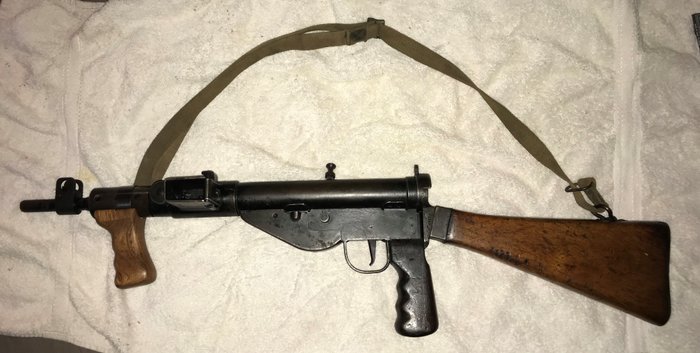 Notice the different barrel and front sight. There were some with foregrips and some without. You also had that wooden shoulder stock. Grell seems to have mixed the later Sterling, which had a standard pistol grip and the Sten, both of which had the magazine sticking out the left side, though the Sten had a stick magazine, while the Sterling's was curved. For this to appear correct, the woman would need to be holding the weapon further back, near the rear of the receiver and have a straighter forearm, to aim. Creative Team: Mike Grell-story & art, Ken Bruzenak-letters, Janice Cohen-colors, Mike Gold-editor Letters page talks about issue #21. Praise is mixed with a letter, who doesn't like the ending of "Widowmaker" as Carla ends up paralyzed. The writer is a paraplegic and wouldn't wish it on anyone. He hopes that Myke will bring compassion to Jon, but felt he is told cold at the end. Mike Gold says Jon is cold and finds it poetic justice and maybe he does need to change and maybe Myke will be that catalyst for change. Synopsis: Jon introduces Myke to the image of Jonathan Lightfoot Sable, his father...  After working the iron mines, he decided to use his brains more. In WW2, he served with the 8th Air Force, as a bombardier, on B-17s... 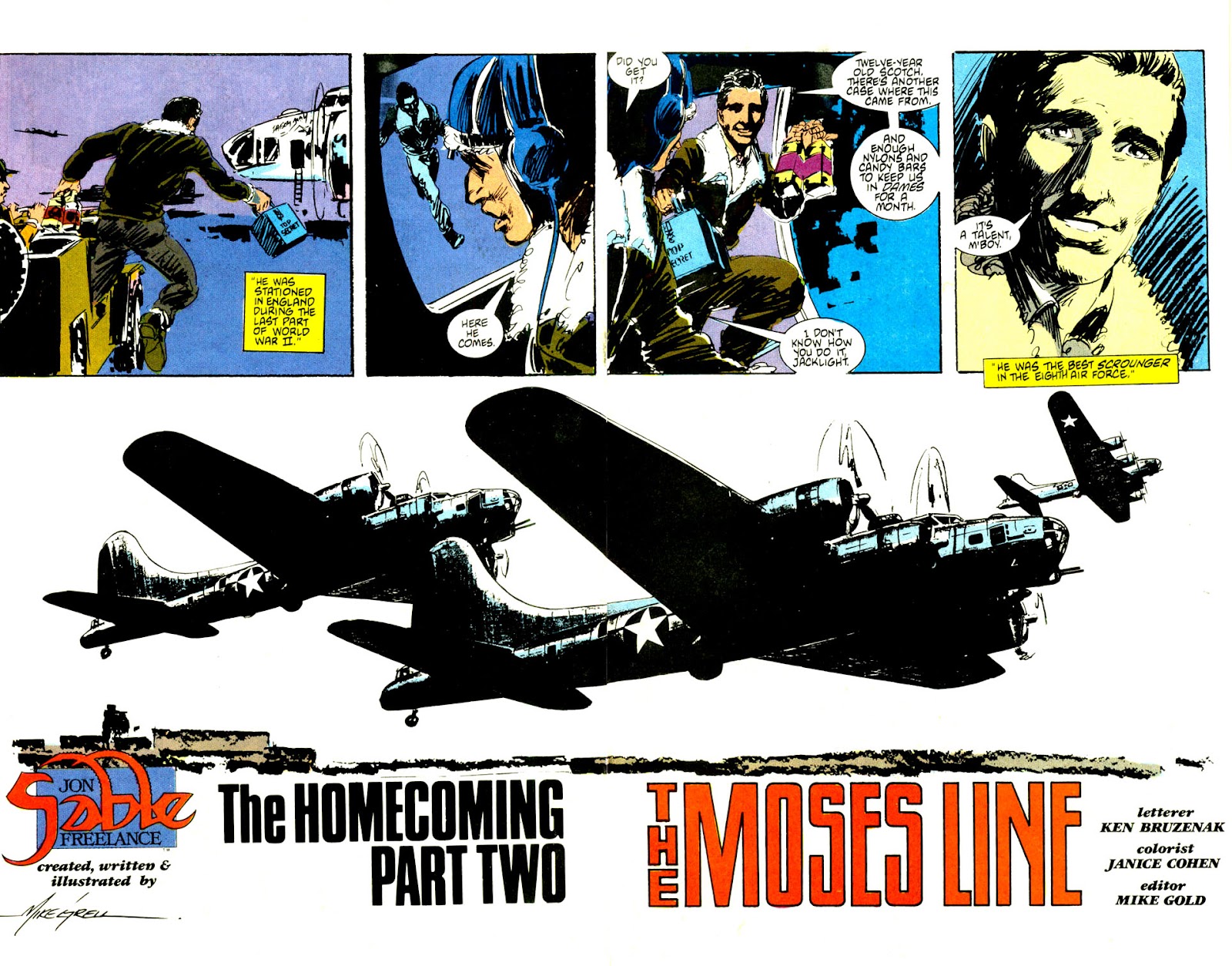 Their plane is hit over Belgium and they hit the silk (after Jacklight, as John is known, destroys the Norton Bombsight). Sable comes down near a farm and approaches the farmer, who helps him hide. Then, he is awakened by German voices. It turns out to be the local Resistance cell, testing to see if he was a German agent, trying to infiltrate their group. This cell is led by a woman, Simone Fortin. She tells him that part of the crew has been captured, and two others are in the care of the Resistance. He is given new identity papers and fitted out with civilian clothes, to make the journey along the escape line, to the Pyranees (via France). Only the leader, Moses, knows the whole route. Simone brings Jacklight to a town and tells him to follow a man putting a red flower in his lapel and then she departs. it turns out that the red flower is the identification for the escape conductors... 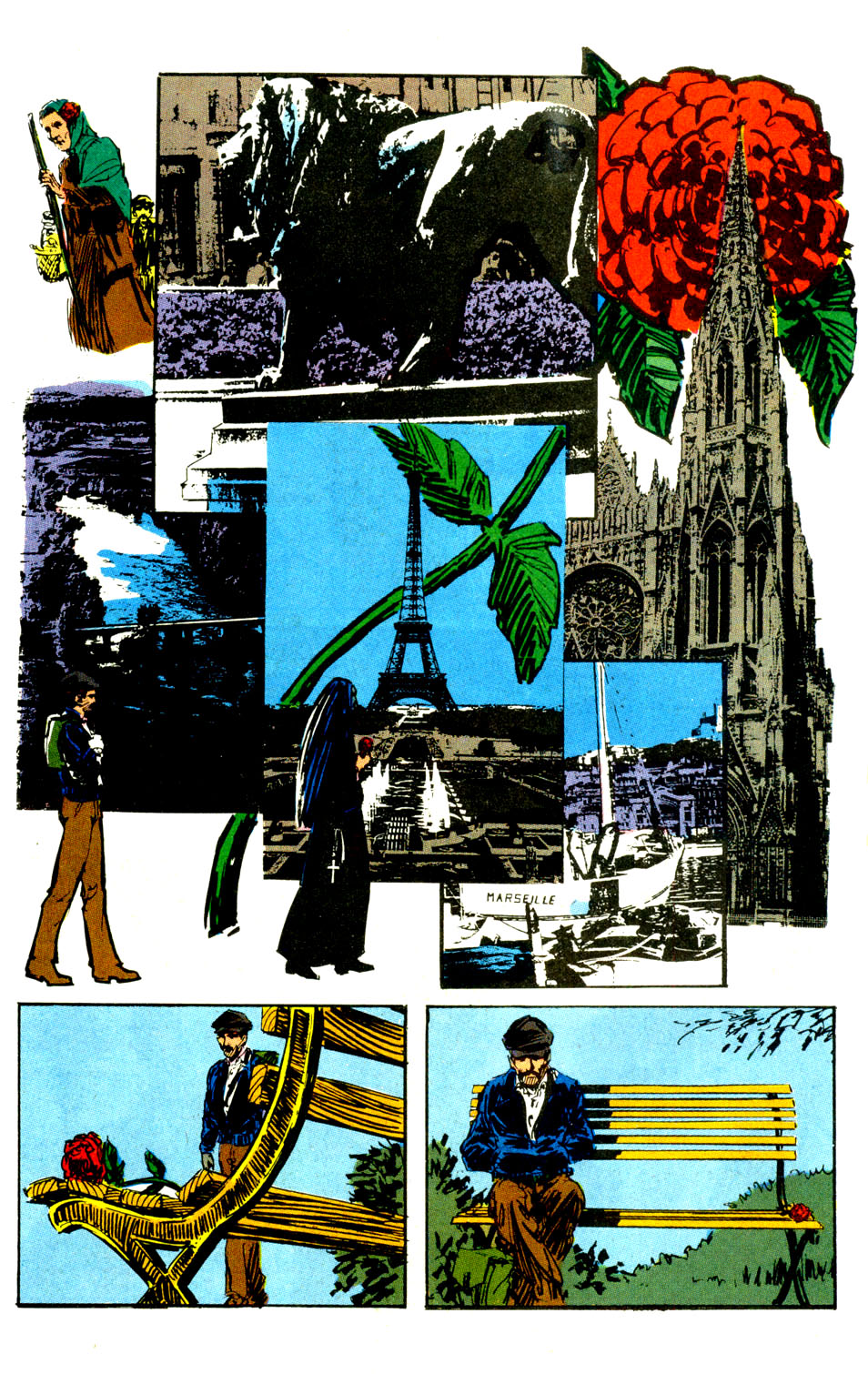 Jacklight waits in a park, in Paris, where he gets a surprise....Simone! She has taken a train south...she is Moses. She will lead him the rest of the way. They climb the mountains and Jacklight has trouble with the trek and stops to rest, dropping his pack on the ground. Simone picks it up and slings it across her shoulders, as she moves on, carrying her own pack and a Sten. ... 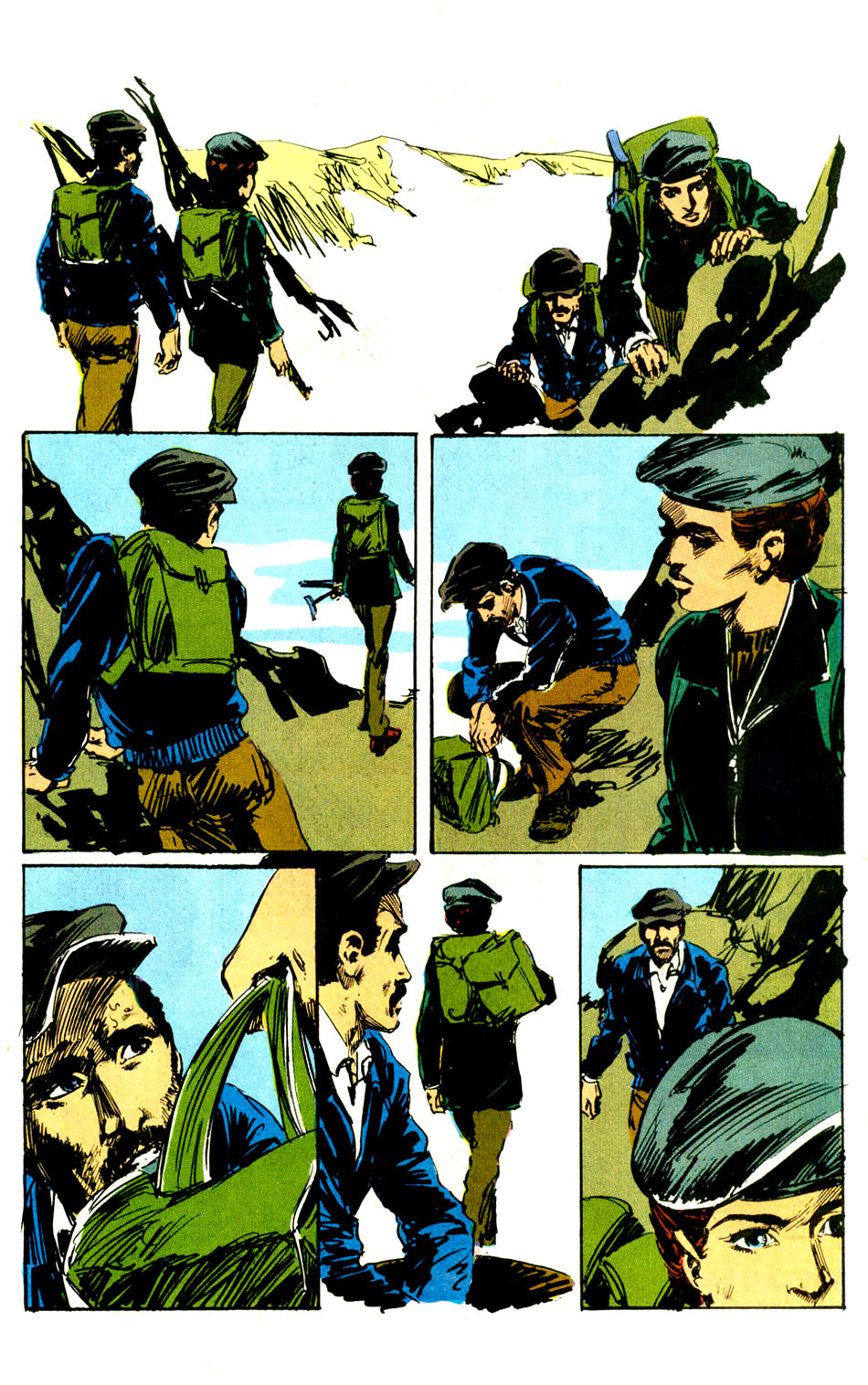 They meet up with a Basque contact, Francisco, who will take them into "neutral" Spain. Jacklight tries to determine if Francisco is an "intimate friend," and Simone tells him to get some sleep, as they will depart before dawn. They are on the downhill run, but that includes climbing down from ledges. They are spotted by a BF-109 patrol plane and are attacked. Simone fire's back (correctly, more or less, here) with the Sten, but loses her grip and falls, but is saved by a broken tree limb. She still fires the Sten, one-handed, and destroys it. She leads Jacklight to a cave, but she is feverish from her wound and her strength is failing. She tells Jacklight to head on, as Gibraltar lies ahead. He tells her she needs a doctor. She'd rather die in the cave then expose her network because the Germans arrested her, while she seeks medical attention. Jacklight leaves. However, he doesn't head for Gibraltar. He spots a German half-track and slips down and steals its medical kit and brings it back to the cave, to treat Simone. She wakes up two days later, for a dinner that would make Monty Python proud.... 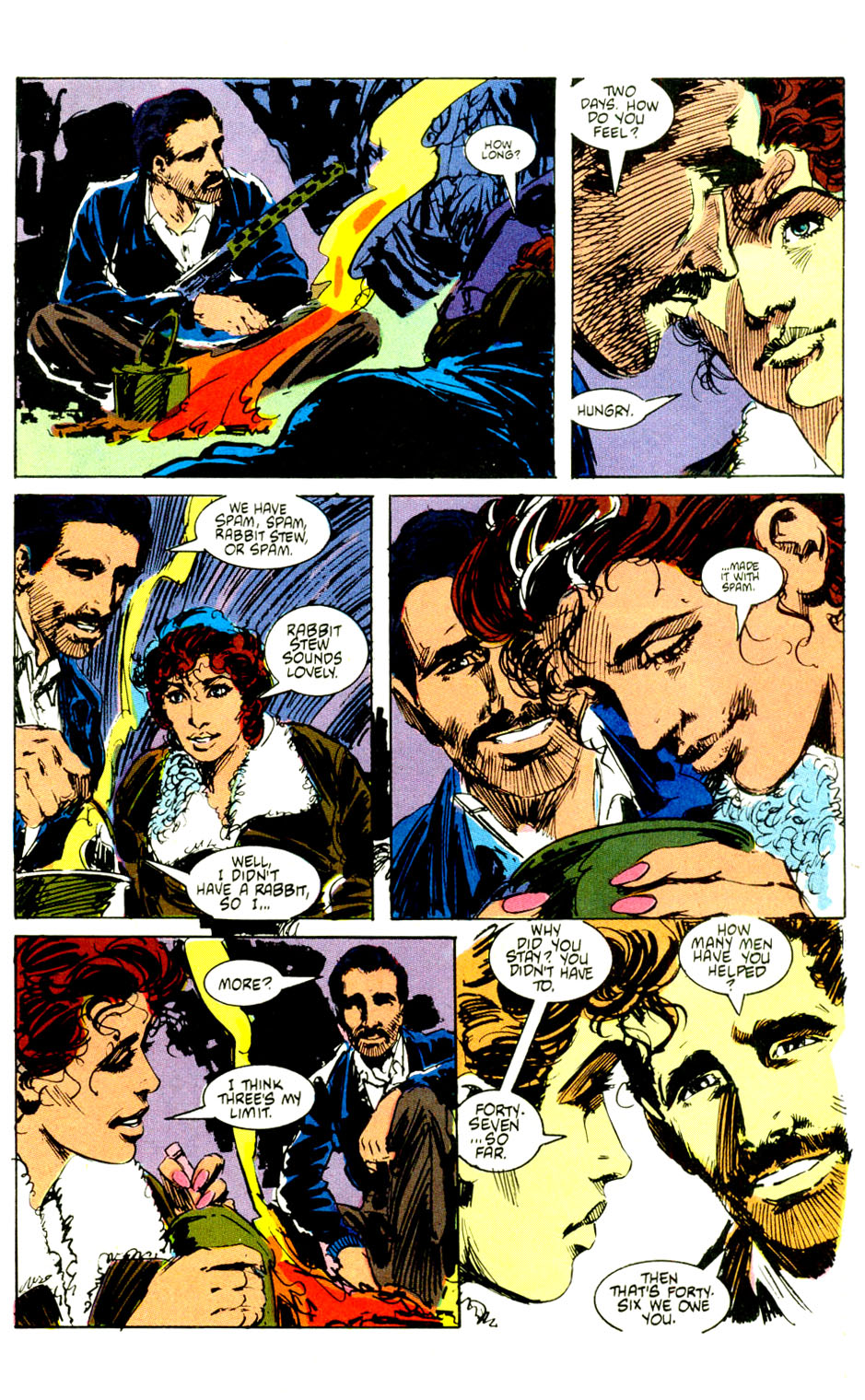 They make love. They make it to safety and Jacklight asks Simone to stay with him, but she won't. She has to help #48. On June 6, 1944, Jacklight gets word from MI-9, the section of the British Directorate of Military Intelligence, which was tasked with escape and evasion plans and routes for Allied aircrews, as well as the escape of Allied prisoners, from POW camps. Moses has been captured by the Germans and feared dead. The rest of the issue is taken up by the next chapter of Shatter, which has less motion and more repetitive images than This Modern World.... 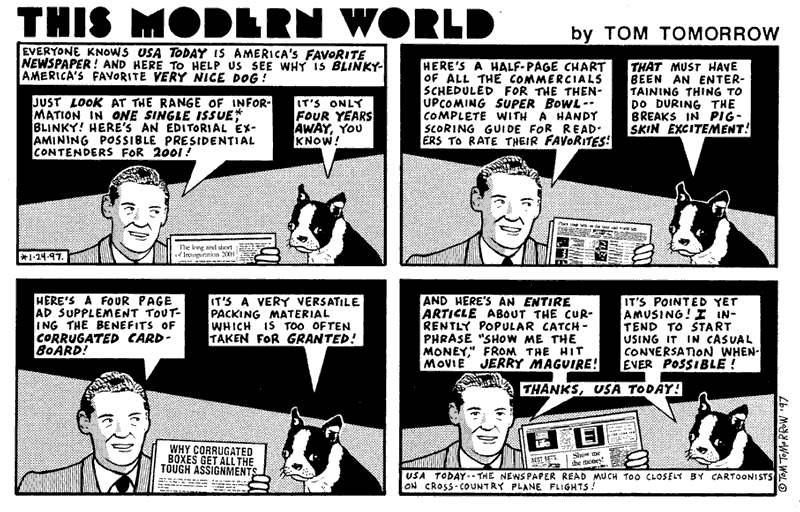 (I used an old one, so nobody has a tizzy. Except maybe Gannett) No dead animals here, unless you count the spam and nobody I know counts that as meat! Thoughts: A thrilling issue, as we follow Jon's father, Jonathan Lightfoot Sable, as he is shot down over Belgium and shepherded by Resistance members along an escape line, to Spain and back to England. Jacklight, as he is known, is a scrounger and a rascal, which informs some of Jon's traits, as he proves to be quite resourceful, and more than a bit of a rogue, with an eye for the ladies. As we learn, the particular lady he meets is more than his match and Jacklight is humbled and deeply respects this woman and the two, thrust together by the war, fall in love. However, by the end, it appears that she didn't survive, after Jacklight made it back to England. Obviously she must have, or Jon would not have been born. That is for next issue. There were actual escape routes established, across Belgium and France. Initially, they were created by the citizens of those countries, who aided soldiers and airman escape to Marseilles, in Vichy France, after the fall of Dunkirk. From there, they would be brought to neutral Spain, by boat or across the Pyrenees, on foot (as seen, with James Coburn, at the end of The Great Escape). Although Spain was officially neutral, they were sympathetic to the Axis powers, as Franco had been aided by the Fascists, during the Spanish Civil War. However, Spain was in no position to become embroiled in WW2, as it had been badly devastated by the fighting and couldn't risk touching off another civil war. Spain did turn a blind eye to German activities within the country, as U-Boats and raiding ships operated from Spanish ports, or intelligence vessels remained moored in their harbor, passing on intel to U-boats and other shipping. British intelligence operated there, trying to uncover German operations, as well as return personnel to England, who came through these escape lines. Many of the Resistance people who worked on these escape lines were women, over half. Women made up 15-20% of the resistance, in France and carried out vital duties, though relatively few were active fighters. One, Marie-Madeleine Fourcade, headed an espionage network, known as "Alliance," which succeeded in gaining intel about the German rocket program, at Peenemunde. When the Germans occupied Vichy France, she went on the run, moving from city to city, while still taking time to give birth to her third child! In 1943, she was brought out of France, to London, where she worked with MI-6. Finally, in 1944, she was allowed to return to France, to oversee her network of agents, as the Allies began their push across France. despite her work and care of 3000 agents and survivors, after the war, DeGaulle ignored her as part of the 1000+ people nominated as Resistance Heroes (of which, only 6 were women). her husband was given the Order of Liberation, but she was not. She did receive honors upon her death, in 1989.  Another Resistance fighter was Simone Segouin, aka "Nicole Minet," who began her career as a courier and messenger, but graduated to working on sabotage missions, derailing trains and other acts of sabotage. She was featured in Life magazine, in 1944. She was present at the liberation of Chartres (where she operated) and Paris. She was awarded the Croix de Guerre. After the war, she became a pediatric nurse. 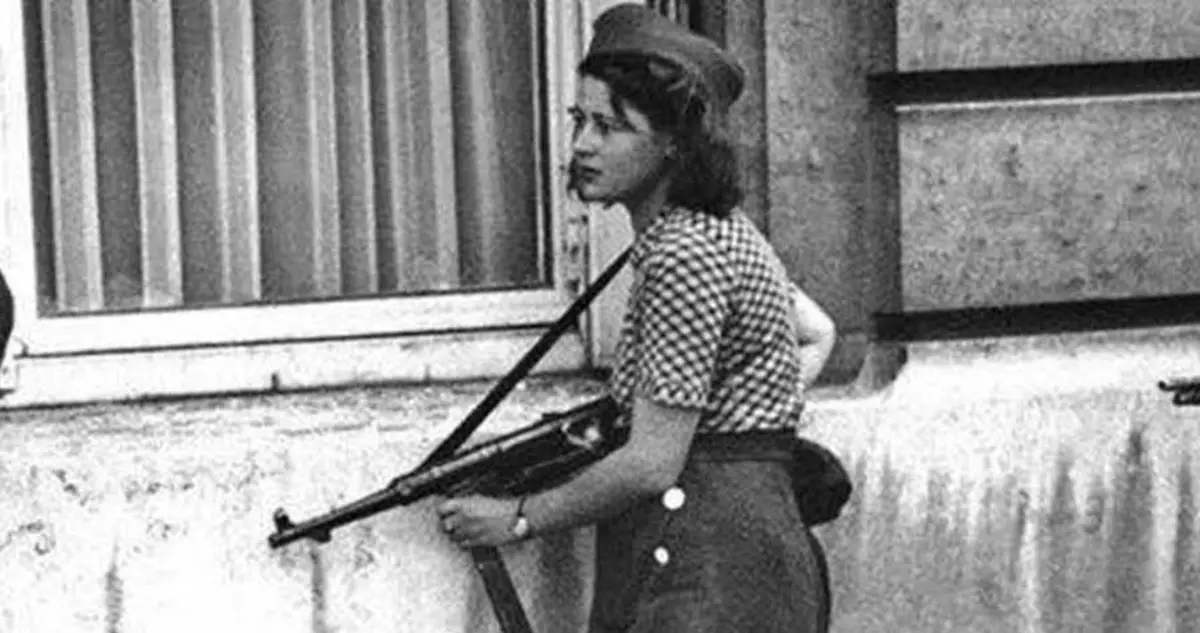 (photo by Robert Capa) Hundreds of other women had active roles in resistance cells across the occupied countries, as messengers, espionage agents, saboteurs, watchers, escape route conductors, cooks, nurses, radio operators and more. Women were part of the SOE teams that were dropped into occupied territory to help coordinate Resistance activities with British Intelligence, as later dramatized in the film Les femmes de l'ombre, aka Female Agents (with Sophie Marceau, Julie Depardieu, Marie Gillain, Deborah Francois and Moritz Bleibtreu) and the UK tv series, Wish Me Luck, starring Kate Buffery and Suzanna Hamilton, as well as Julian Glover. Paul Verhoeven directed the film Zwartboek (Black Book), starring Carice Van Houten (Game of Thrones), as a Jewish woman in the Dutch Resistance, as a spiritual sequel to his earlier Soldat van Orange (Soldier of Orange) about Erik Hazelhoff Roelfzema, based on his memoir, recounting his friends from university and their involvement in the Dutch Underground, flying for the British and serving as an aid to Queen Wilhemina (as well as one joining the Dutch SS and serving on the Eastern Front). Sophie Marceua's character, in Female Agents, was inspired by the exploits of Lise de Baissac, a French woman raised in the British colony of Mauritius, in Africa, who was parachuted into France, in 1942, to organize Resistance cells. She worked with her brother Claude, who worked in the Scientist network, in France. Lise worked alone, liasoning between networks and her work was of great use in the elad up to D-Day, helping to stall the German response. After liberation, she and her brother hunted for and found Marie Hubert, with whom Claude had a daughter and they returned to England. Lise later worked for the BBC and then married her teenage sweetheart (they met as teens; she didn't rob the cradle), who was a successful artist and interior designer, in Marseille. he died in 1978 and she passed in 2004, at age 98, living in a spectacular apartment with a view of Marseilles. These women inform Simone Fortin, both in her physical toughness, but her efficiency and commitment to fighting the Germans. Many of these women were discovered by the Gestapo and were tortured, raped, imprisoned and executed. in other countries, women fought in the Partisans and fought in and alongside the Red Army. Some of the best snipers in the Red Army were women and the famous Night Witches, the 588th Night Bomber Regiment, which was greatly feared by the Germans. Mike also name drops James Langley, who writes the message that is delivered to Jacklight, informing him that Moses was captured and presumed dead. James Langley was a real person. he was an officer, in the Coldstream Guards, who was wounded at Dunkirk. He was forced to be left behind and had his left arm amputated by a German doctor, due to his wounds. He escaped from the hospital and eventually made his way to Marseilles, in Vichy France, where he worked as a messenger for an escape line, before being repatriated. he then went to work for MI-6, acting as a liason with MI-9; and, was attached to SHAEF. There, he was involved in organizing escape routes and reception centers, including areas behind enemy lines, for escaped POWs, after their camps were liberated, before they could be safely brought across Allied lines. His group was heavily involved in Operation Pegasus, which worked with British military and Dutch Resistance to bring out British Airborne troops, caught on the wrong side of the Rhine, after the collapse of Operation Market Garden. Among the troops that assisted with these operations were E Company, 506th Parachute Infantry regiment, of the 101st Airborne, celebrated in the book Band of Brothers, by Stephen Ambrose, and the HBO mini-series, from Tom Hanks & Steven Spielberg. Some really great stuff in this issue, both from a character perspective and a historical one, as it dramatizes a reality, of which most readers would be unaware. it's a shame that Grell never did any of the war comics titles or originated his own project, as his style and his attention to detail is perfect for such things. One of the details that Mike includes is a pressed red flower, in Jon's family album, next to a picture of Jacklight, in uniform. As we see in the story, that flower was of great importance to him. Fantastic issue and another reason why this series was so far above much of what happening in the mainstream.
|
|
|
|
Post by brutalis on Oct 30, 2021 18:56:01 GMT -5
Oh how the mind boggles pondering on What If Grell had created a DC (OR FOR ANY PUBLISHER) War series. Grounded in such realism, characterization and Mike's art, it would have been spectacular.
A Mademoiselle Marie ongoing would have sold big time. A Grell run with the Loser's should have been pushed after Kirby. How much depth Grell would have given the bandaged Unknown Soldier. A Sgt. Rock run of "episodic" mini-series from Iron Mike. I see ALL this in my mind and my mouth begins salivating...
|
|
|
|
Post by foxley on Oct 30, 2021 23:42:22 GMT -5
And I'd love to see his take on "Code Name: Gravedigger", brutalis .  Excellent summary and analysis, as always, codystarbuck . Your comments about the women of the resistance compels me to mention Australia's own heroine of the French resistance, Nancy Wake, whom the Nazis nicknamed 'the White Mouse' because of her uncanny ability to escape. (And The White Mouse became the title of her autobiography.) Nancy ran away from home at 16 and became a nurse. With a small inheritance from an aunt, she moved to New York, and then London where she trained herself as journalist. In the 1930s, she worked in Paris and later for Hearst newspapers as a European correspondent. She witnessed the rise of Adolf Hitler and the Nazi movement and "saw roving Nazi gangs randomly beating Jewish men and women in the streets" of Vienna. In November 1939, she married wealthy French industrialist Henri Fiocca. She was living in Marseilles, France when Germany invaded. During the war in France, Wake served as an ambulance driver. After the fall of France to Nazi Germany in 1940, Wake became a courier for the Pat O'Leary escape network led by Ian Garrow and, later, Albert Guérisse. As a member of the escape network, she helped Allied airmen evade capture by the Germans and escape to neutral Spain. In 1943, when the Germans became aware of her, she escaped to Spain and continued on to the United Kingdom. Her husband was captured and executed. After reaching Britain, Wake joined the SOE under the code name "Hélène". On 29–30 April 1944 as a member of a three-person SOE team code-named "Freelance", Wake parachuted into the Allier department of occupied France to liaise between the SOE and several Maquis groups in the Auvergne region. She participated in a battle between the Maquis and a large German force in June 1944. In the aftermath of the battle, a defeat for the maquis, she claimed to have bicycled 500 kilometers to send a situation report to SOE in London. Wake was awarded the George Medal, the US Medal of Freedom (with Bronze Palm), the Croix de Guerre, the Médaille de la Résistance, and was made a Chevalier de la Légion d'Honneur in 1970 and an Officier de la Légion d'Honneur in 1988. she died in 2011 at the age of 98. And was quite the looker.   |
|
|
|
Post by tartanphantom on Oct 31, 2021 13:44:08 GMT -5
Good synopsis, codystarbuck, but I want to offer one minor clarification regarding the bombsight.
While on the other hand, THIS is a Norton--
While I'm sure there were many time that Norton was bombed, I doubt he needed a bombsight to do it..  |
|
|
|
Post by codystarbuck on Oct 31, 2021 16:51:55 GMT -5
Good synopsis, codystarbuck , but I want to offer one minor clarification regarding the bombsight.
While on the other hand, THIS is a Norton--
While I'm sure there were many time that Norton was bombed, I doubt he needed a bombsight to do it..  No, no......this is the Norden Bombsight...... |
|
|
|
Post by codystarbuck on Nov 4, 2021 14:35:07 GMT -5
Jon Sable #27 Well, you know what they say about marketing; sax sells! Creative Team: Mike Grell-story & art, Ken Bruzenak-letters, Janice Cohen-colors, Mike Gold-editor Letters page has compliments for the character development in issue #22 and a request for a wildlife portfolio, based on the Safari Sketchbook. Synopsis: Jon continues the story of his youth. We skip ahead to 1951, when a ship approaches New York City and a small boy from Belgium gets a view of the Statue of Liberty.... 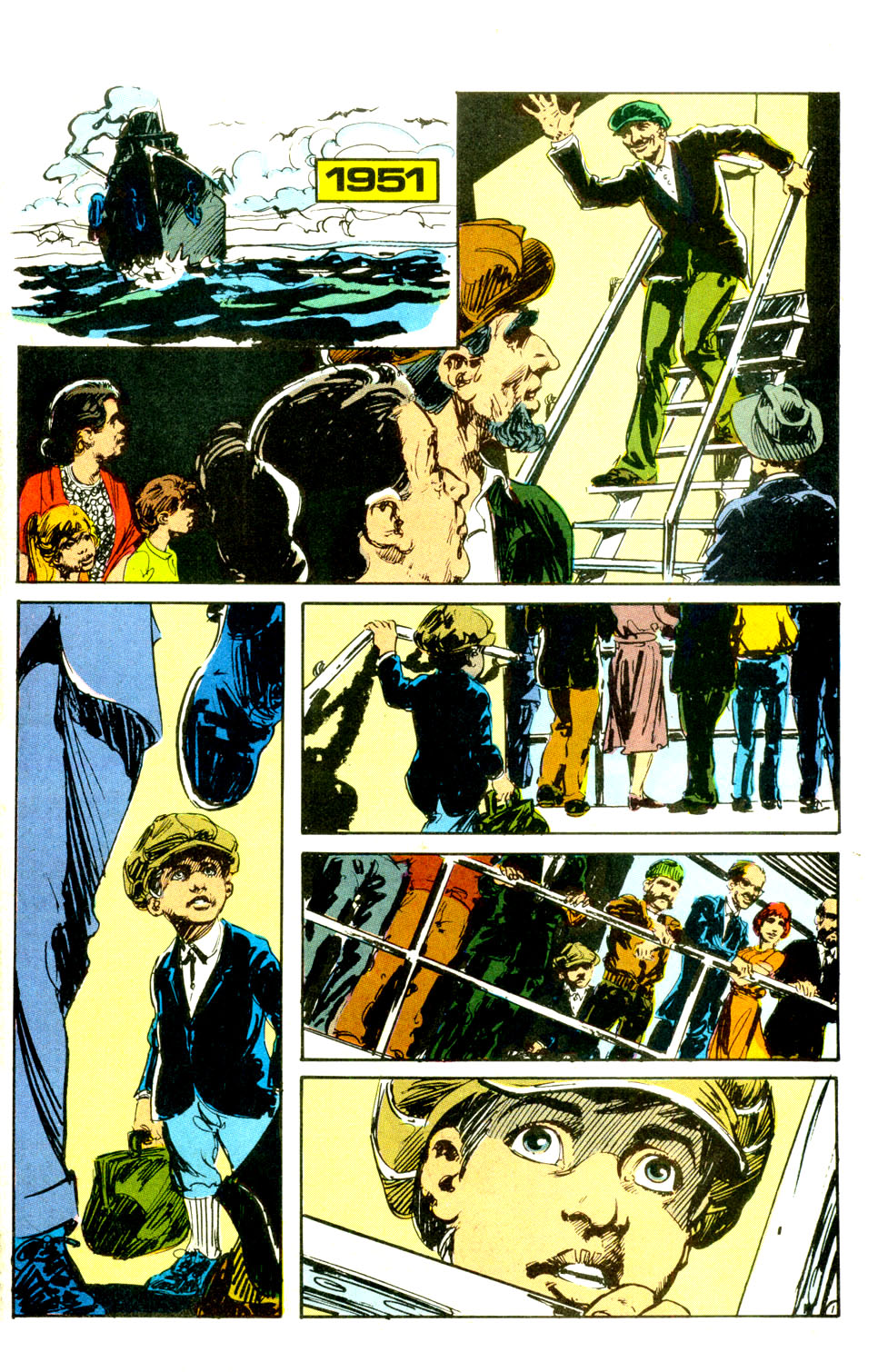 (I know, I know....they missed a rather important group that was already here...) Young Jon Moses is processed through Ellis Island and he looks out at the statue, but his thoughts are about the person who did not make the journey with him... 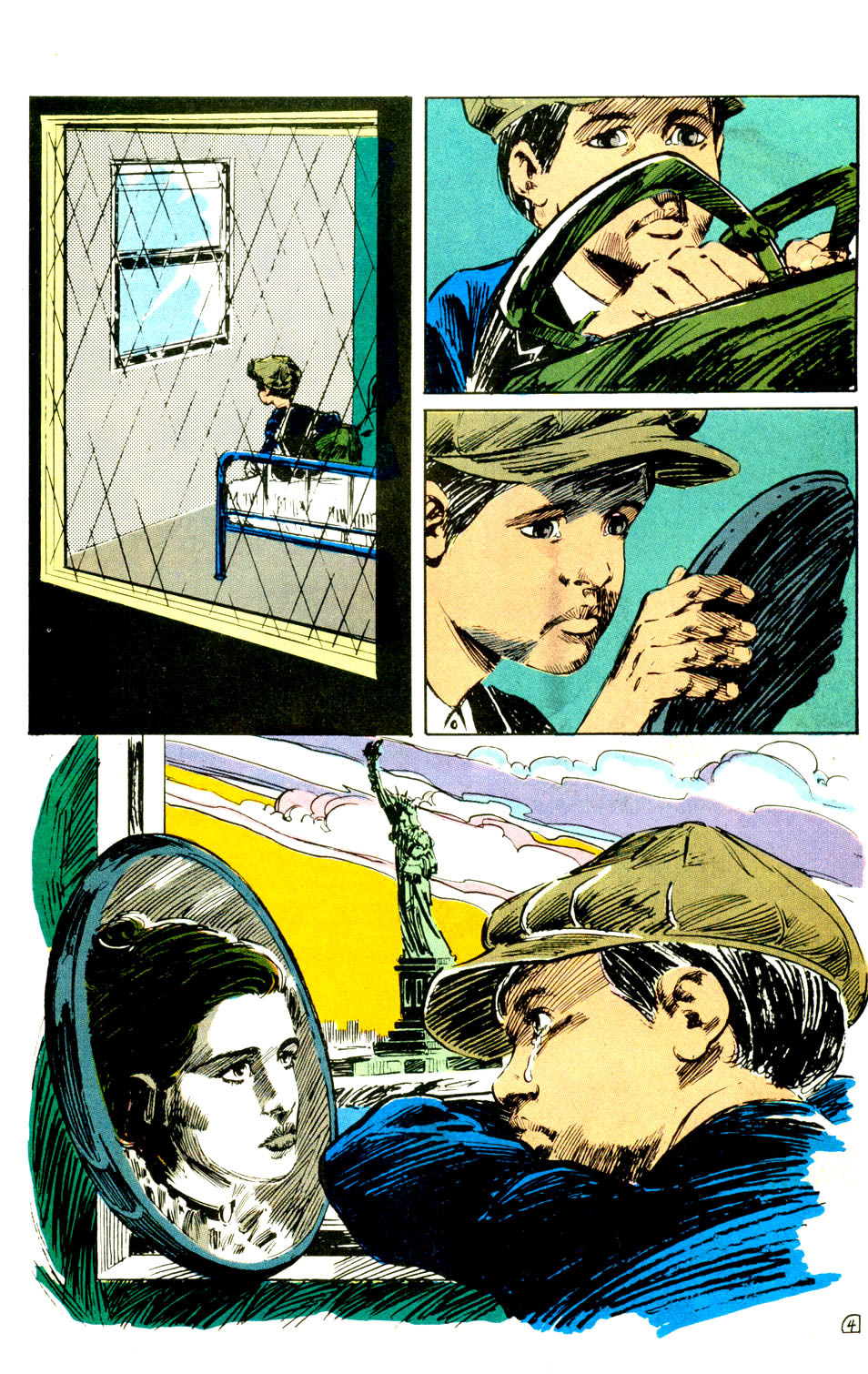 "Learned to live with his limitations".....Horse Hockey! You look at that image of a boy longing for his mother and tell me Mike Grell can't draw! Soon, Jon Moses meets an American who knows of his family... 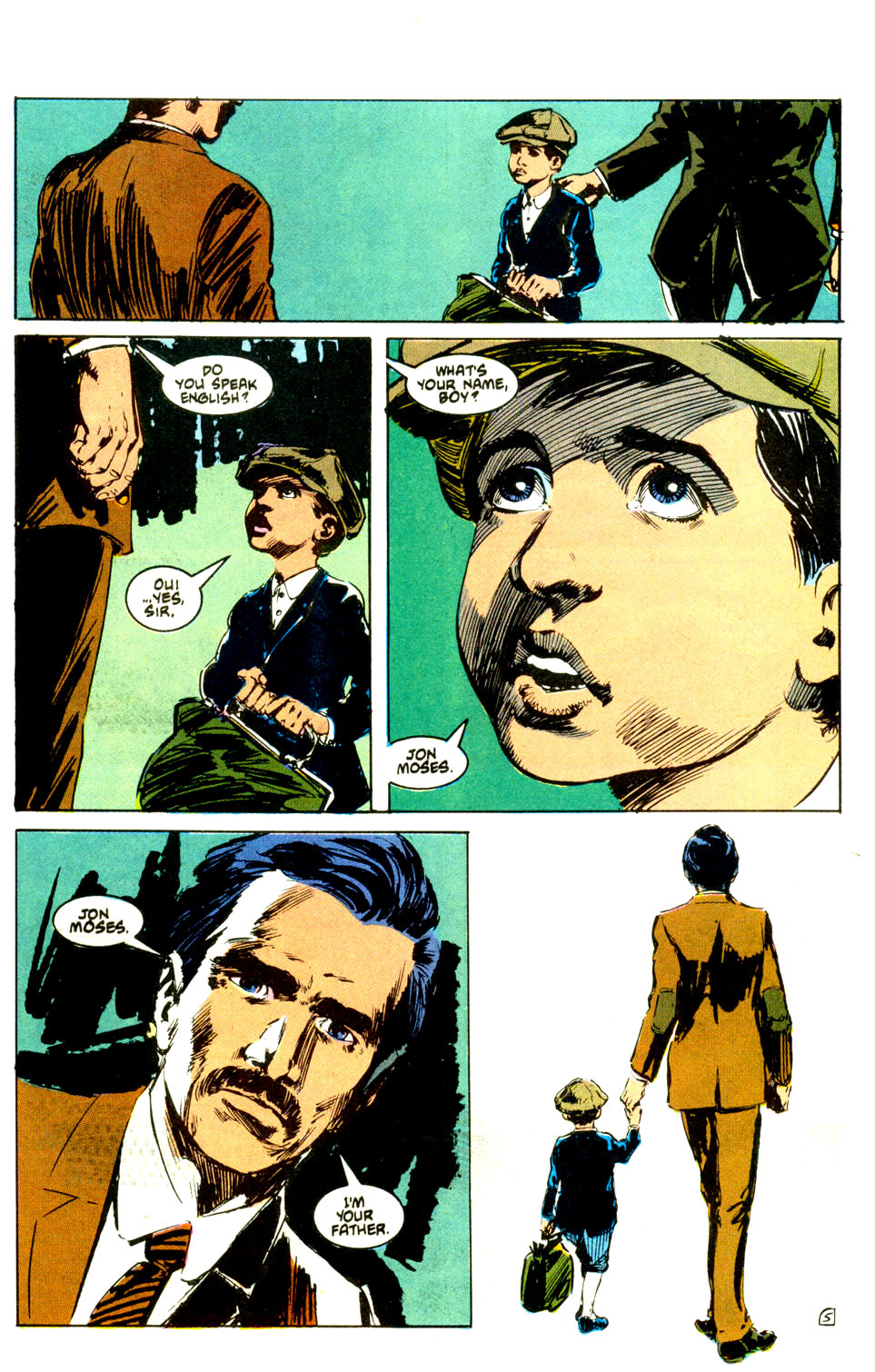 Jon speaks to Myke of his father, with respect for claiming him and bringing him to be a part of his family, despite the trouble it caused him.  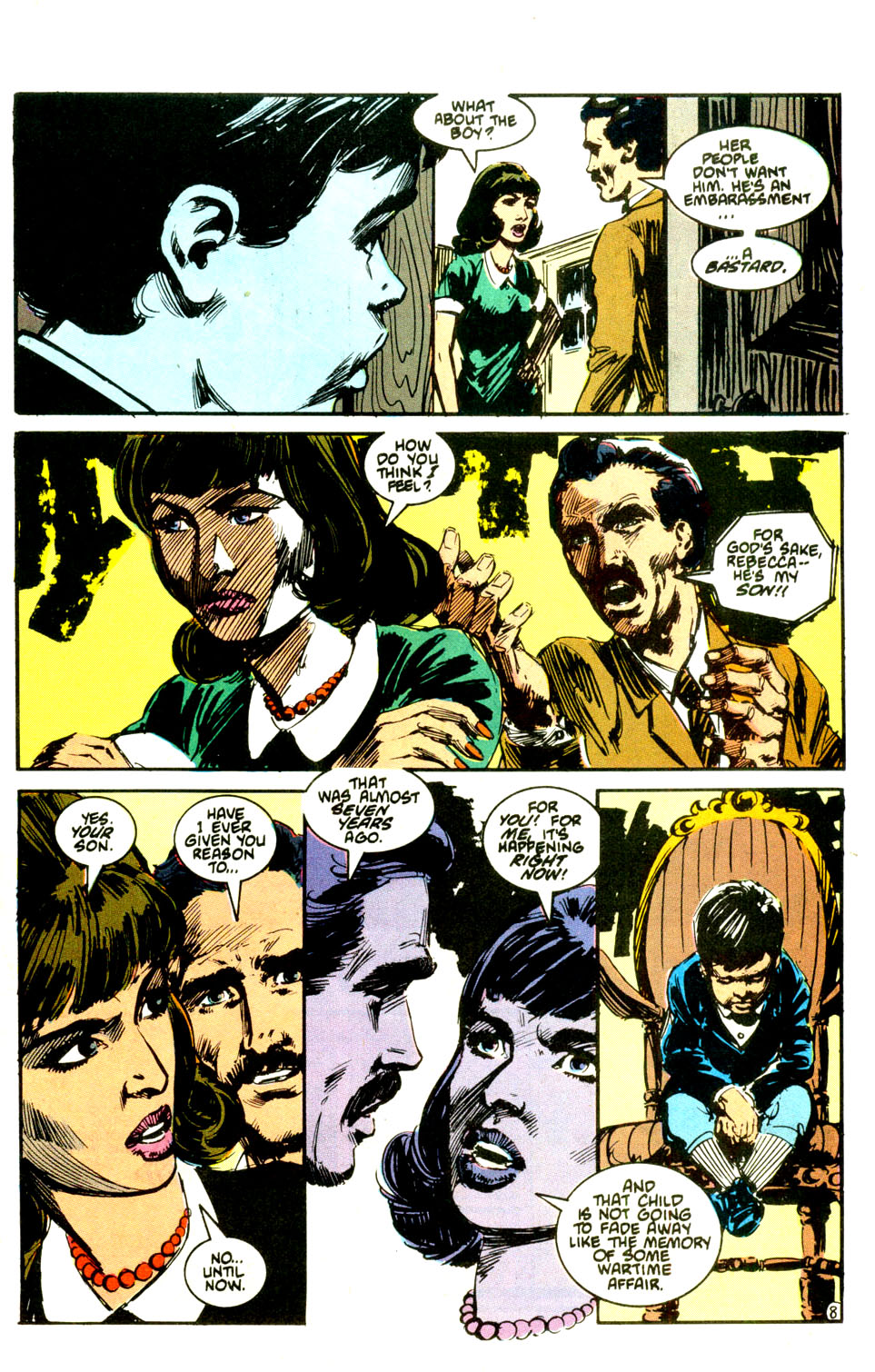 Jon was sent to a military boarding school, in part to remove him from his step-mother. It wasn't a better environment and he got into fights. His father came to claim him and asked why he got into another fight. He tells his father that he just found out what "bastard" meant. Jon was brought home and spent his youth in Vermont, where he grew into an adolescence, with girls, hot-rods, and a DA. Jon proceeded to get into any trouble he could find, his father left to smooth it over with the authorities. It took years for Jon to understand his father's perspective. He turned down an appointment to West Point, which his father arranged, which drove them further apart. He cut off funds as Jon went to a local college, paying his own way by playing sax in a dance band. It was there that Jon took up the Modern Pentathlon and it gave him the discipline he had lacked. From there it was off to Vietnam, then back to serious training and competition, culminating in the Olympics, in 1972, where he met Elise. Jon tells Myke about Rachel and his mission, that she died alone, like Elise. Myke asks why he brought her to his old home and he says he is 40 and alone...and he wanted her to understand... 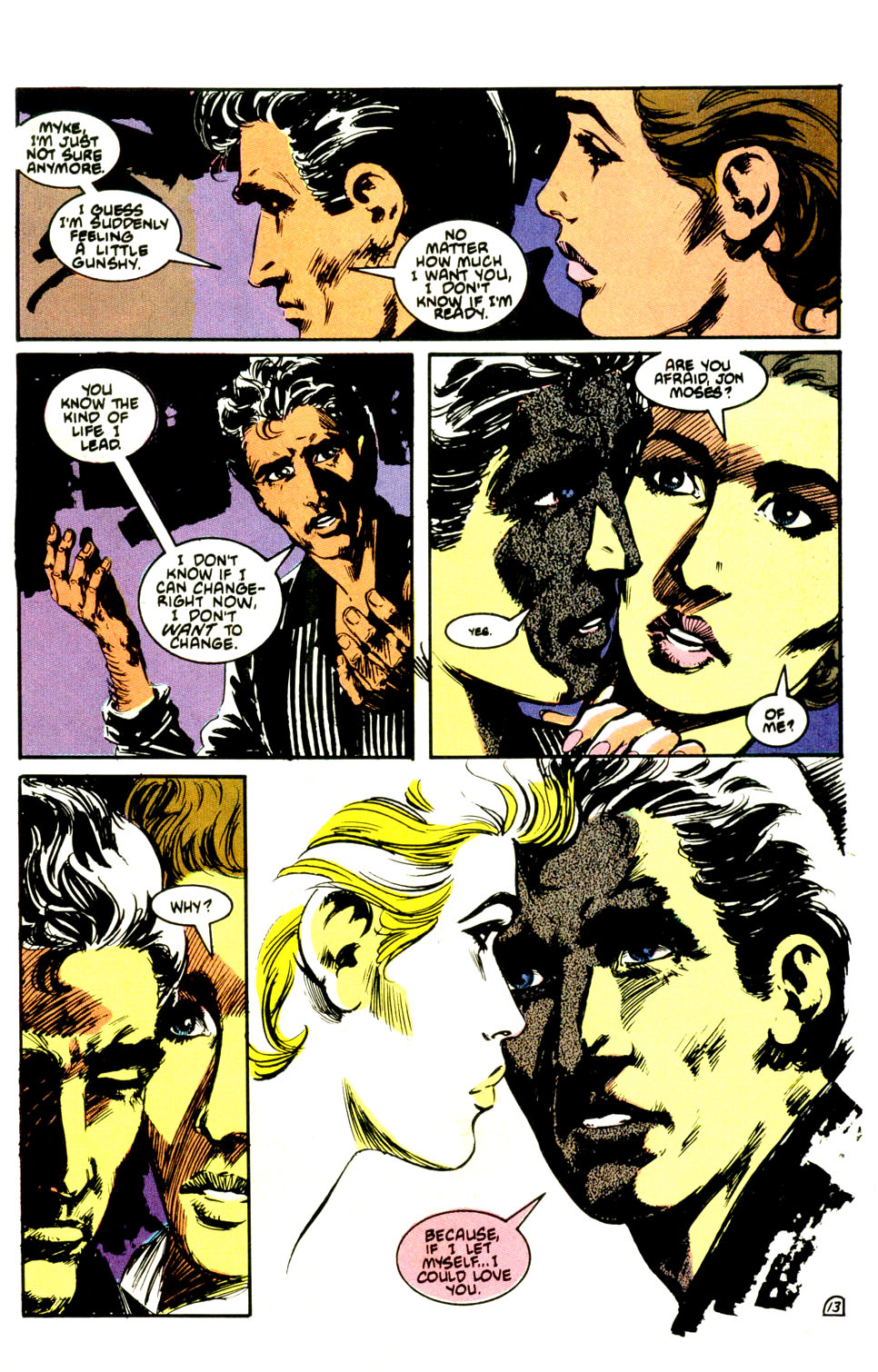 Myke tells him life doesn't come with guarantees. She wishes him happy birthday and then tells him why she came there. Jon stares at the photo of Elise and Myke slips off her dress. Jon pulls out his saxophone, from its case and plays a few notes, while visions of Elise and Myke dance in his head. He puts the instrument down and goes to his bedroom, where Myke is waiting for him. She pulls back the sheet and they make love. Thoughts: A story that is nothing but character development, in comics. It shouldn't be revolutionary, but it was. Mike knocked it out of the park. For 2 years, he had introduced and developed Jon Sable, a conflicting concoction of action hero and sensitive writer, a man who loved his family and lost them to violence, then immersed himself in violence for revenge and a chance to join them. He didn't die, like he wanted. Part of him wanted to live. He returned home and picked up the pieces of his life and found himself at an odd crossroads. His life story wouldn't sell, but the stories he told his kids, at bedtime would, and did. But, the wolf still needed to hunt wild game. He could live with that, until his illustrator forced him to talk to her about the work, and then about himself. She caught him off guard, broke through his defenses. He played the normal games, to keep her at a distance, maybe a little fling, but nothing more; yet, she broke through. Like Elise, she could see through the facade, to the man underneath. Not the international mercenary, not the glorified private investigator; but to the man who loved his children so much he created a world of leprechauns, living in Central Park, to delight them and make them giggle. The man who connects to their memory, every time he writes another story, for other children to delight and giggle. She got to Jon Moses, pushing aside Jon Sable, Freelance. Far too many comics, movies, tv and even novels would have rushed this story; but, Mike took his time. People are complex and not everyone comes together with just dinner and dancing. For some, it is a long journey to arrive at love. A comic about love, that doesn't have a young woman weeping on the cover. Revolutionary. Macho adventure, with real romance and growth. Mack Bolan never had that; James Bond only got close to one woman, for more than just sex. Where do we go from here? That is the real question. Jon and Myke are now lovers; not like Jon and Eden, where it was more about company, for a brief moment. Real lovers. Sparrow is still alive. Jon is still in a dangerous business. He's 40 and his reflexes are slowing. Can he continue as he has? Will he start second guessing his instincts? Will he lose his edge? That is for another issue. Next time, Jon Moses follows in the footsteps of a guy named Sam........and a Maltese Falcon!
|
|
|
|
Post by codystarbuck on Nov 4, 2021 14:43:03 GMT -5
ps the reproduction of Mike's art is greatly improved with this issue. Either they solved their technical issue or Mike was able to adapt his style to the new printing materials.
Shatter continued. It will stick around for the next 3 issues, then go off to live it own life.
|
|
|
|
Post by foxley on Nov 4, 2021 15:16:07 GMT -5
ps the reproduction of Mike's art is greatly improved with this issue. Either they solved their technical issue or Mike was able to adapt his style to the new printing materials. Shatter continued. It will stick around for the next 3 issues, then go off to live it own life. It's still really hard for me to believe that people ever thought Shatter and its computer generated art was going to be the future of comics. |
|
|
|
Post by codystarbuck on Nov 4, 2021 18:10:39 GMT -5
ps the reproduction of Mike's art is greatly improved with this issue. Either they solved their technical issue or Mike was able to adapt his style to the new printing materials. Shatter continued. It will stick around for the next 3 issues, then go off to live it own life. It's still really hard for me to believe that people ever thought Shatter and its computer generated art was going to be the future of comics. I think it was more that they thought computers would be the art tool of the future; which, to a certain extent, proved to be true. Mike Saenz' method was based on the technology of the period and it was better suited to gaming graphics that sequential storytelling or animation. Computers proved to be a major innovation for comic book production work, with lettering and coloring pretty much having traditional tools replaced completely by computers. Drawing has since evolved, with the introduction of drawing tablets and other peripherals and softwares, to where many comic artists are working on computers for at least part of their creative process (even if it is just scanning in the art to sent to someone else on the team. A select few publishers thought that CD Rom comics were the wave of the future, including Innovation and that never panned out. However, digital did end up becoming a major platform for comics, just with a different delivery system. Besides, I was supposed to have a flying car that folded into a briefcase, according to certain predictions... Or, at least a jet pack! *Trivia fact: The voice of Jane Jetson, Penny Singleton, was also Blondie Boopadoop Bumstead, in the Blondie series of films and tv series, opposite Arthur Lake, as Dagwood! George O'Hanlon , who voiced George Jetson, start in a series of comedy shorts, as Joe McDoakes, for Warner Bros (which he wrote). |
|
|
|
Post by codystarbuck on Nov 9, 2021 1:09:43 GMT -5
Jon Sable #28 You will need to read the following, before starting this issue.... 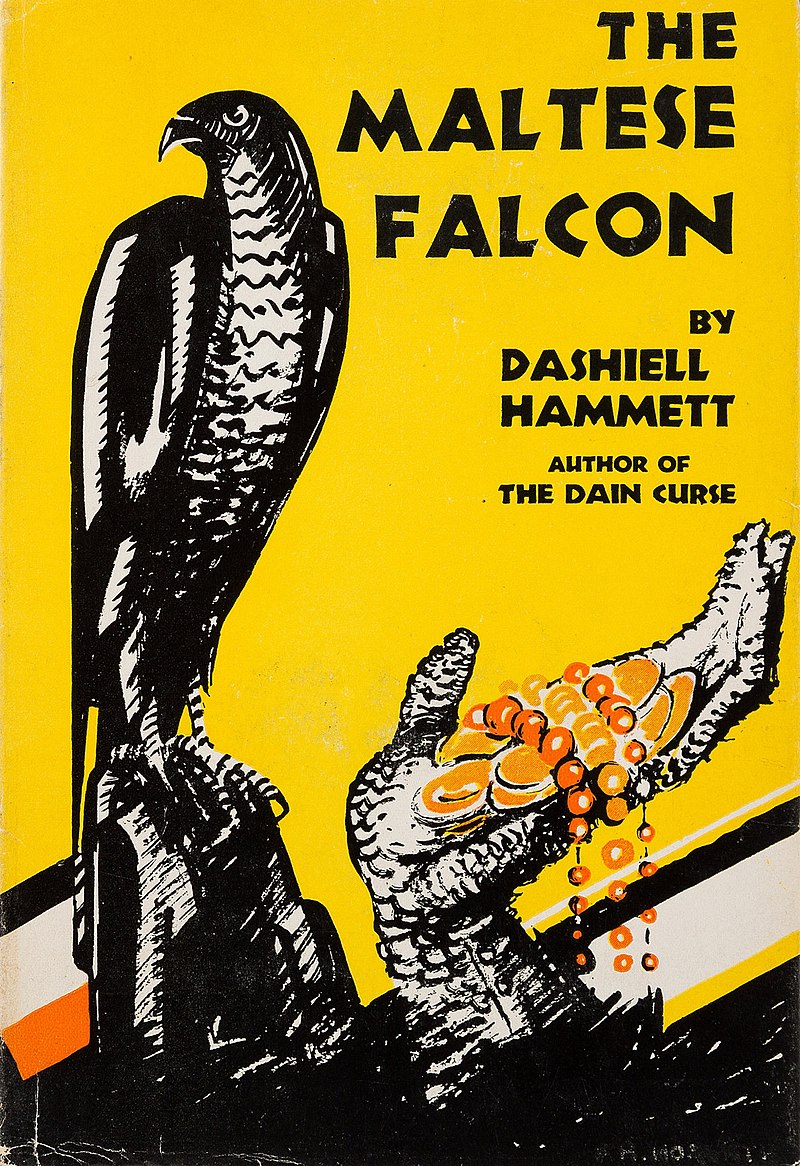 Better get started. I'll wait. Done? Okay, now watch this...... You can try this version; but it's a bit like reading the Cliffs Notes.... Creative Team: Mike "Shamus" Grell-story, art, gumshoes; Ken "Letters" Bruzenak-calligraphy, invisible ink, coded messages; Janice "Doc Martin" Cohen-colors, bloodstains; Mike "Pot o" Gold-editor, snitch The letters page contains a single letter, calling Grell's African hunt "murder." Mike gives a spirited reply...  Synopsis: Synopsis: Jon is outside his childhood home, chopping wood for the fire, when shots ring out. He runs into the house to find Sparrow....  Jon flings his axe at him, but misses, as Sparrow retreats, bragging about leaving a present. Jon finds Myke's dead body, in the bed, naked, a gunshot wound to each eye. Jon wakes up screaming. Myke cradles his head and calms him down, whispering soothing words. After Jon has his heart rate back under control, Myke asks if he wants to tell her about it. Jon is hesitant and tells her it was about Sparrow and he will come for him, someday. Myke asks why. "Because I didn't kill him, when I had the chance, "Jon replies. Jon warns her not to get to close to him, as he doesn't want to lose her. He tells her that Sparrow is the best there is. Jon goes off to the shower and is surprised by Myke joining him, telling him she isn't afraid. Jon says he is. They return home, and come to the conclusion that some things have changed, but others haven't....  Jon sees figures in the window of his place, though he recognizes some of them. He enters and finds Sonny up to some new tricks....  The "dead guy," is Wichita Kaintuck, an old stuntman partner of Sonny's. They were having a little reunion and party, with some ladyfriends. Sonny tells Jon about a party thrown by Mae Aston, daughter of producer Miles Aston, who collected all kinds of movie memorabilia from sets. They are going to be auctioned off and there will be all kinds of celebrities there. Jon calls Myke to invite her, but she is on deadline. She suggests taking Eden and Jon remembers he owes her an outline and the party might placate her. Eden does agree to go to the party and it turns out to be a trip into the Land of Make-Believe...  Sonny introduces Jon and Eden to their hostess, Mae Aston, who introduces her conversation partners, Mr Greenburg and his female assistant Jo Carr. Sonny goes off to look at Howard Hill's bow, from The Adventures of Robin Hood, while Eden and Jo go off to find the Ladies Room. Jon talks to Greenburg, who has heard of him, though Jon can't say the same. Greenburg is a jeweler and speaks of the theft of El Capitolio, as he was a bit of a rival to Sir Henry, and was amused by the theft. Sonny calls Jon over to look at Kirk Douglas' helmet, from The Vikings, which looks rather familiar, as drawn by Grell....   Eden comes back and is rather put out. As Mae Aston calls everyone to the auction, Eden whispers that Jo Carr is a lesbian and asked her if she'd like to "...take a spin in a 'Carr,' with the top down." Carr walks past and winks at her. Jon laughs boisterously, until Eden slams her heel into his foot. Mae Aston is about to start the charity auction, with the first item: Howard Terpning's original painting for the Gone With The Wind movie poster. Aston goes to retrieve the item and screams. Jon rushes in and finds her next to an empty pedestal, where the original prop statue from The Maltese Falcon had rested. Someone has stolen it! Shatter continues. Thoughts: This comic is the stuff that dreams are made of! I couldn't resist. We'll get to the main plot, in a moment. First, we conclude things with Jon and Myke, not exactly basking in the glow of carnal pleasure. Mike fakes us out with tragedy, but it factors into the very real fear of Jon's that Sparrow will come for him and anyone close to him might be caught in the crossfire. He also blames himself, because he took personal revenge over putting down a dangerous animal. In the end, he pushes Myke back away, a bit, though he does tell her that she gives him the thrill he has only felt with danger. He has a reason to live; but, he is pragmatic enough to not want Myke near him to become further collateral damage. They have progressed; but, the concerns over Sparrow cause Jon to take a step back. Now, the fun bit. This is all a big riff on classic Hollywood, in general, and the classic 1941 film adaptation of The Maltese Falcon, in particular. Wichita Kaintuck is obviously inspired by legendary stuntman Yakima Cannutt... 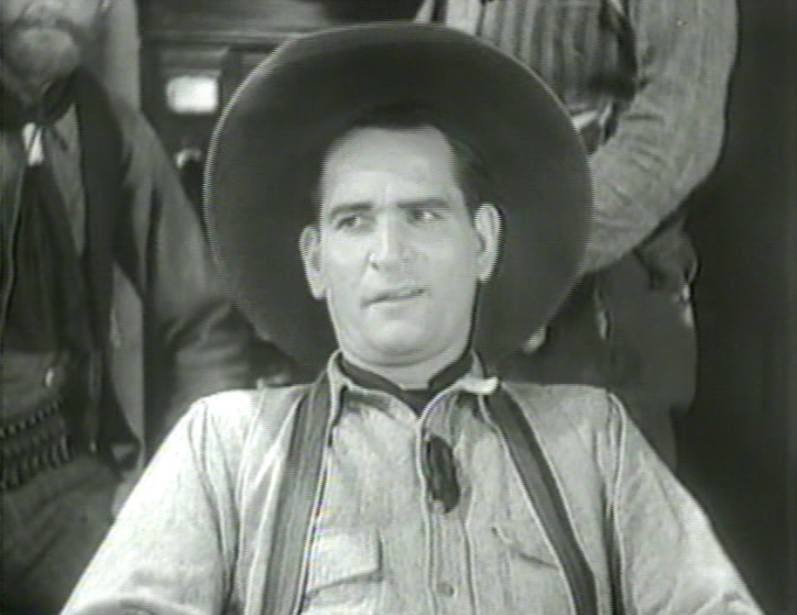 Canutt was considered the greatest of the Hollywood stuntmen, of the Golden Age. He performed the legendary runaway stagecoach stunt, in John Ford's Stagecoach, where he climbs under the coach to the back, climbs over the top, and drops down on the horses to stop them. He reprised the extremely dangerous stunt in Republic's Zorro's Fighting Legion, where he doubles reed Hadley as Zorro. The stunt was later mimicked, twice, in 1981, for the films The Legend of the Lone Ranger and Raiders of the Lost Ark. Terry Leonard did the stunt in both films; but was badly injured in Lone Ranger, when his leg went below the coach wheel. He got to try again, with Raiders, but insisted that Glen Randall Jr drive the truck. The shots of Harrison Ford hanging in the front had him seated on a bicycle seat, mounted on the front of the truck. The other characters introduced are all variations on the actors and their corresponding characters from the 1941 version of The Maltese Falcon, directed by John Huston. Mae Aston is based on Mary Astor, who was the love interest, Brigid O'Shaughnessy, who masquerades as a Miss Wonderly, to hire Spade & Archer (Sam's partner, Lew Archer), to follow a man named Floyd Thursby, who has run off with her sister. Lew Archer takes the first shift to follow Thursby and is murdered, as is Thursby and Spade is the main suspect. While trying to clear his name and find out what Thursby was really doing, he meets a slimy little psycho, named Joel Cairo, who is a homosexual, and is in the employ of a mysterious fat man, named Gutman. Joe Cairo was played by Peter Lorre and Gutman by Sydney Greenstreet. Joel Cairo became Jo Carr and went from a homosexual man to a homosexual woman. Sydney Greenstreet becomes Mr Greenburg. In the novel and film it is Gutman who explains the history of the Maltese Falcon, a fabulous statue of a black falcon that was part of a treasure of the Knights of Malta. It was to be a gift to the King of Spain, but was intercepted by pirates and had changed hands many times, usually through murder. The statue is actually made of gold and encrusted with jewels and was later covered in a black enamel paint. Gutman hired O'Shaughnessy to retrieve it from a White Russian General, in Constantinople (Now it's Istanbul, not Constantinople.... She brought in Joel Cairo to help, then she and Floyd Thursby double-crossed them and fled to Hong Kong and then San Francisco. So, the story is a bit meta, as the characters mirror those of The Maltese Falcon, while their target is the actual prop from the film... 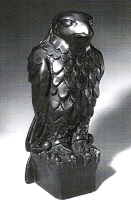 Sprinkled throughout the party are all kinds of old props: Errol Flynn's boots, from They Died With Their Boots on, the violin from Johnny Belinda, Dirty Harry's Smith & Wesson Model 29 .44 Magnum (though Grell draws the barrel a bit shorter, though some of that may be down to foreshortening, due to the angling of the prop display), Howard Hill's bow (Hill double Errol Flynn to create the archery stunts, in The Adv of Robin Hood), Kirk Douglas' Viking helmet (which inspired the design of The Warlord, in Grell's comic) and the original Maltese Falcon statue. Grell is indulging in his love for classic films, which has permeated his work, over the years. The early issues of the Warlord featured homages to Spartacus and Ben Hur, as well as Edgar Rice Burroughs tales of Pellucidar and his Land That Time Forgot (which he swiped from Conan Doyle's The Lost World). Starslayer had Merlin and made reference to The Once and Future King (particularly as portrayed in The Sword and the Stone segment). Jon's safari gear owed much to Stewart Granger, in King Solomon's Mines, right down to the same leopard hatband (though Grell said the clothes were general safari gear, though the hat was Granger, when I asked about it). Earlier in the series, when Jon and Grey discuss fencing, Jon mentions that Basil Rathbone was the best of the Hollywood set, which was true, as he was an accomplished fencer and did his own stunts in sword scenes. he goes on to say that Oliver Reed, in The Three Musketeers (and The Four Musketeers) fought like it was real, as that film features more realistic battles, with characters using a main-gauche, a dagger used to parry sword thrusts, as well as their cloaks and other weapons, not to mention dirty tricks, like a kick to the goolies! This is the purest of Jon Sable's detective adventures, as we are firmly in the realm of the hardboiled detective, as pioneered by Dashiell Hammett and Raymond Chandler. Hammett had been a Pinkerton Detective, in San Francisco, who contributed mystery stories to Black Mask magazine. In fact, the Maltese Falcon was serialized in the magazine, in 1929, before it was published, as a novel, by Alfred A Knopf publishing, in 1930. Hammett said Sam Spade wasn't based on a particular detective; rather, he was what they all dreamed of being. other characters did have some basis in Hammett's past work, both as a detective or in his writing, as he reworked elements from previous stories. The book was adapted the following year (1931), starring Ricardo Cortez and Bebe Daniels. This was pre-Hays Code and there are allusions to sex, Brigid O'Shaughnessy is seen in the bath and is strip searched (behind a closed door) by Spade, and there are more overt references to the homosexual relationships of Cairo, Gutman, and the hood Wilmer. Warner Bros tried to re-release the film in 1936, but was blocked by the Code, when they were denied approval. It was adapted again, in 1941, by John Huston, who both wrote and directed. Humphrey Bogart is Spade and the film did much to elevate his status in Hollywood. Mary Astor is O'Shaughnessy and Peter Lorre is Cairo. Sydney Greenstreet is Gutman and Elisha Cook Jr is Wilmer. Because of Lorre's appearance, they downplayed Cairo's supposed good looks (Spade's secretary, in the novel, refers to Cairo as "gorgeous," and upped the psychotic element. Cook gets roughed up by Spade, then tries to kill him, later. In the novel, Spade goads him with taunts of "sweetheart," and "precious." The 1931 version has more of that; but, the Hays Code prevented that in this version, with more veiled allusions to Wilmer and Cairo being homosexuals, mostly through mannerisms that statements. The novel is considered one of the greatest detective novels, ever and the template that most writers of hard boiled crime fiction followed. the film is a masterpiece of the film noir genre, as well as the detective film. Huston constructed a masterpiece, while maintaining the integrity of the novel, with quotable dialogue, characters stolen and homaged for generations, as well as staging, lighting and storytelling techniques that were copied by everyone. Bogie wasn't first choice, as George raft turned down the role of Sam Spade; but, this marked the first collaboration between Bogart and Huston and cemented a lifelong friendship and working partnership, leading to Treasure of the Sierra Madre, Key Largo and The African Queen. Huston had planned to make The Man Who Would Be King with Bogart and Clark Gable, in the 1950s; but, Bogart's health and other complications prevented it. The actual film Falcon prop was sculpted by artist Fred Sexton, based on the "Kniphausen Hawk," a pouring vessel from the late 1600s, created for Count Georg Wilhelm von Kniphausen, of the Holy Roman Empire. That item featured a hawk, perched on a rock, encrusted by jewels. The prop stood 11.5 inches tall and several were made for filming. Jack Warner gave one to actor William Conrad, which sold for $398., 500 at auction, in 1994, the highest price paid for a movie prop, at the time. Another prop version, from the film, sold for over $4 million, in 2013. The origin of the Maltese Falcon lay in an annual tribute, paid by the Grandmaster of the order of St John of Jerusalem (The Knights Hospitaller, aka The Knights of St John, aka the Knights of Malta), to the Holy Roman Emperor Charles V, for the grants of Malta, Tripoli and Gozo. The tribute was a falcon, presented each year, on All Saints Day (Nov 1). Within the novel, this statue of a falcon is created as a present for the King of Spain. So, next issue will begin Jon's investigation into the theft and the questioning of witnesses and suspects. Expect some more fun and homages.
|
|
|
|
Post by foxley on Nov 9, 2021 2:15:03 GMT -5
There was something going round comic creators in the 80s that compelled then to put the Maltese Falcon into comics (not that I'm complaining. I love the novel and the film). Besides this classic tale, the 1987 Silverblade maxi-series by Cary Bates and Gene Colan features the Falcon prop (or, more accurately, on of the many copies made of it) in a prominent role.
But no mention of the 1936 version Satan Met a Lady? And I suspect Iron Mike might have drawn an idea or two from the 1975 spoof-sequel The Black Bird, which featured George Segal as Sam Spade, Jr. Not a great film (The Man With Bogart's Face is a much better take on a similar idea), but it does have Lee Patrick and Elisha Cook Jr. reprising their roles of Effie Perrine and Wilmer Cook.
|
|
|
|
Post by codystarbuck on Nov 9, 2021 12:29:03 GMT -5
There was something going round comic creators in the 80s that compelled then to put the Maltese Falcon into comics (not that I'm complaining. I love the novel and the film). Besides this classic tale, the 1987 Silverblade maxi-series by Cary Bates and Gene Colan features the Falcon prop (or, more accurately, on of the many copies made of it) in a prominent role. But no mention of the 1936 version Satan Met a Lady? And I suspect Iron Mike might have drawn an idea or two from the 1975 spoof-sequel The Black Bird, which featured George Segal as Sam Spade, Jr. Not a great film ( The Man With Bogart's Face is a much better take on a similar idea), but it does have Lee Patrick and Elisha Cook Jr. reprising their roles of Effie Perrine and Wilmer Cook. I stuck with the direct adaptations and not the lesser efforts. Neil Simon's The Cheap Detective also recreates some of the scenes and plot (as well as stuff from The Big Sleep) and Steve Martin's Dead Men Don't Wear Plaid uses actual footage from it (and The Big Sleep), with Martin inserted, as well as other gangster and film noir classics (like Double Indemnity). The Tiny Toons clip I included, with They Might Be Giants, kind of references the Maltese Falcon, which is why I included it (aside for the joke). Looney tunes used to reference all of the Warner Bros films, though I am blanking on any direct parody of The Maltese Falcon. They did riffs here and there on Bogie as Sam Spade, Peter Lorre (both as Joel Cairo and his other roles) and later spoofed Casablanca, in the mid-90s. For real fun, check out Charlton's The Phantom #70.......  Story is by Bill Pearson and art by Don Newton. Title is "Mystery of the Mali Ibex." It features an adventure of the Phantom of the 1930s and 40s as he chases after a criminal, in North Africa and elsewhere and the stolen golden statue of an ibex. The story is a massive Bogart riff, pulling in elements of The Maltese Falcon, Casablanca, Treasure of the Sierra Madre and The African Queen. The issue is great fun, as were all of the issues that Don Newton handled, for the end of Charlton's run with the newspaper hero. |
|
|
|
Post by codystarbuck on Nov 13, 2021 22:23:35 GMT -5
Jon Sable #29 "Don't worry about the story's goofiness. A sensible one would have had us all in the cooler."-Sam Spade Creative Team: "Iron" Mike Grell-story & art, "Pen & Ink" Ken Bruzenak-letters, Lady with the Reds" Janice Cohen-colors, "Pyrite" Mike Gold-editor Letters page includes one that hopes Grell didn't receive "...too many death threats from the anti-hunting people in the world." Mike Gold asks, "...how many death threats would you deem an acceptable number?" Synopsis: The police arrive at Mae Astor's place, in the form of Lt Chambers, who knows of Sable, thanks to Capt. Josh Winters, who had nothing good to say. Jon tells him to lighten up , because someone has stolen the Maltese Falcon! The cops start taking statements and we start gathering evidence and motives.... 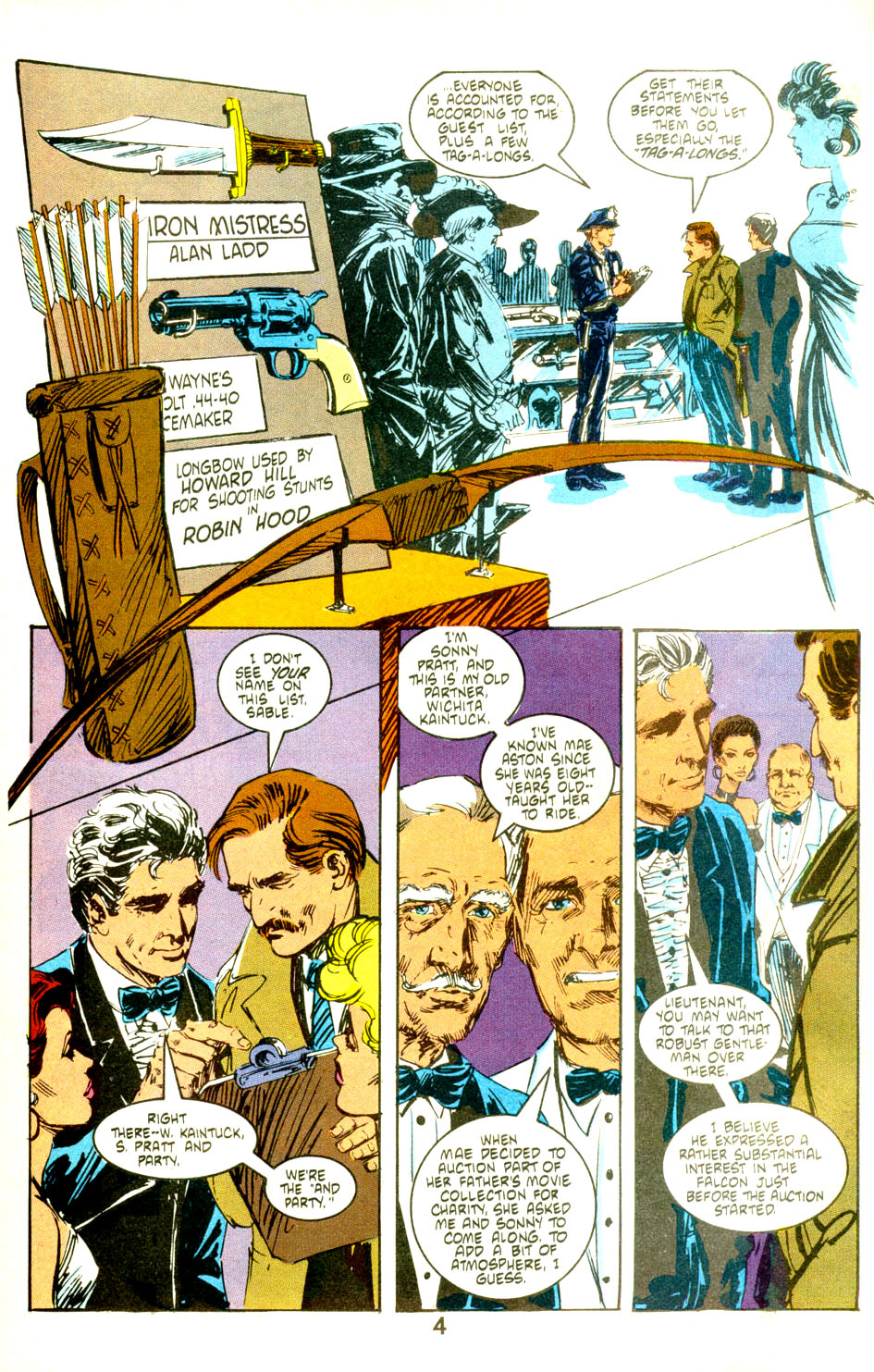 Greenberg offered $100,00 for the statue, before auction, but was turned down by Aston, since it was being sold for charity. Greenberg makes a comment that Astin turned down all of his offers, and gives his assistant, Jo Carr a sideways glance. He also points out he was standing next to Sable when the statue was stolen, which sable confirms. They confirm a time of two minutes between when the statue was last seen and the scream rang out. Sable figures it as 10 seconds from when Astin left the room and screamed. They figure enough time to take the statue through the open window. Astin states that the insurance had lapsed, in her father's bankruptcy, so therew as no insurance motive. Jon estimates the statue weighed 60-70 lbs and Astin couldn't have gotten far with it, in 10 seconds. Sable questions why fake the auction, if there was no insurance and Chamber retorts with Greenberg's offer. Sable points out that it likely would have brought more at auction and Chambers confirms that several guests indicated they were willing to go as high as a quarter of a million. Also, it is revealed that Astin was going to get half of the auction price, which would still beat Greenberg's offer; so, no motive and not much opportunity. Chambers doesn't like Sable, who just shot holes in his theories and tells him he wants him to stay out of the case. Jon laughs at that.... 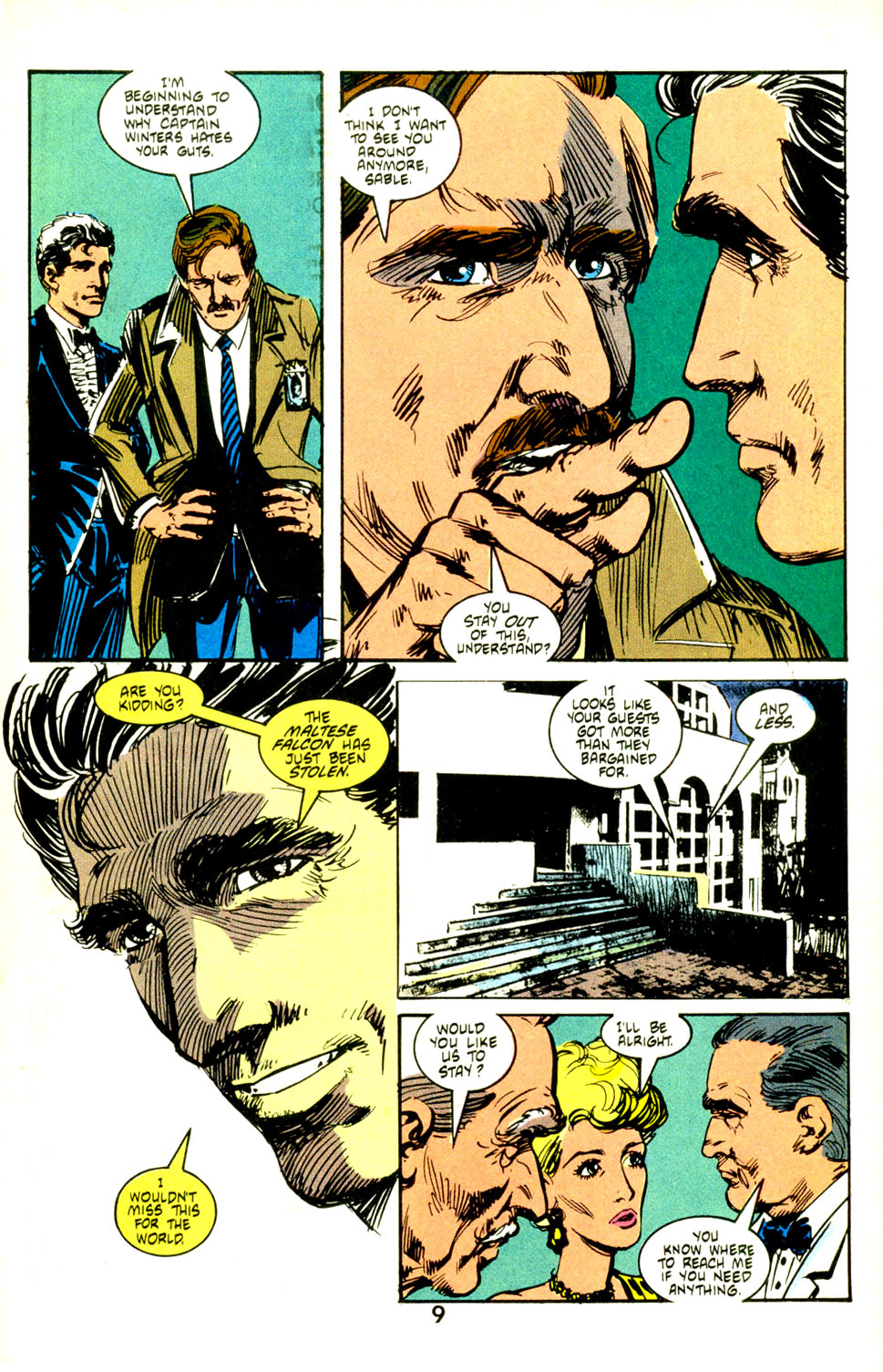 Jon secures Mae Astin's blessing to investigate, on his own dime, for fun. He puts Eden in a car, then hears Astin scream and runs back in the house and she says something about a man outside the window, where the statue may have disappeared and Sable jumps the guy and gets his butt whooped. 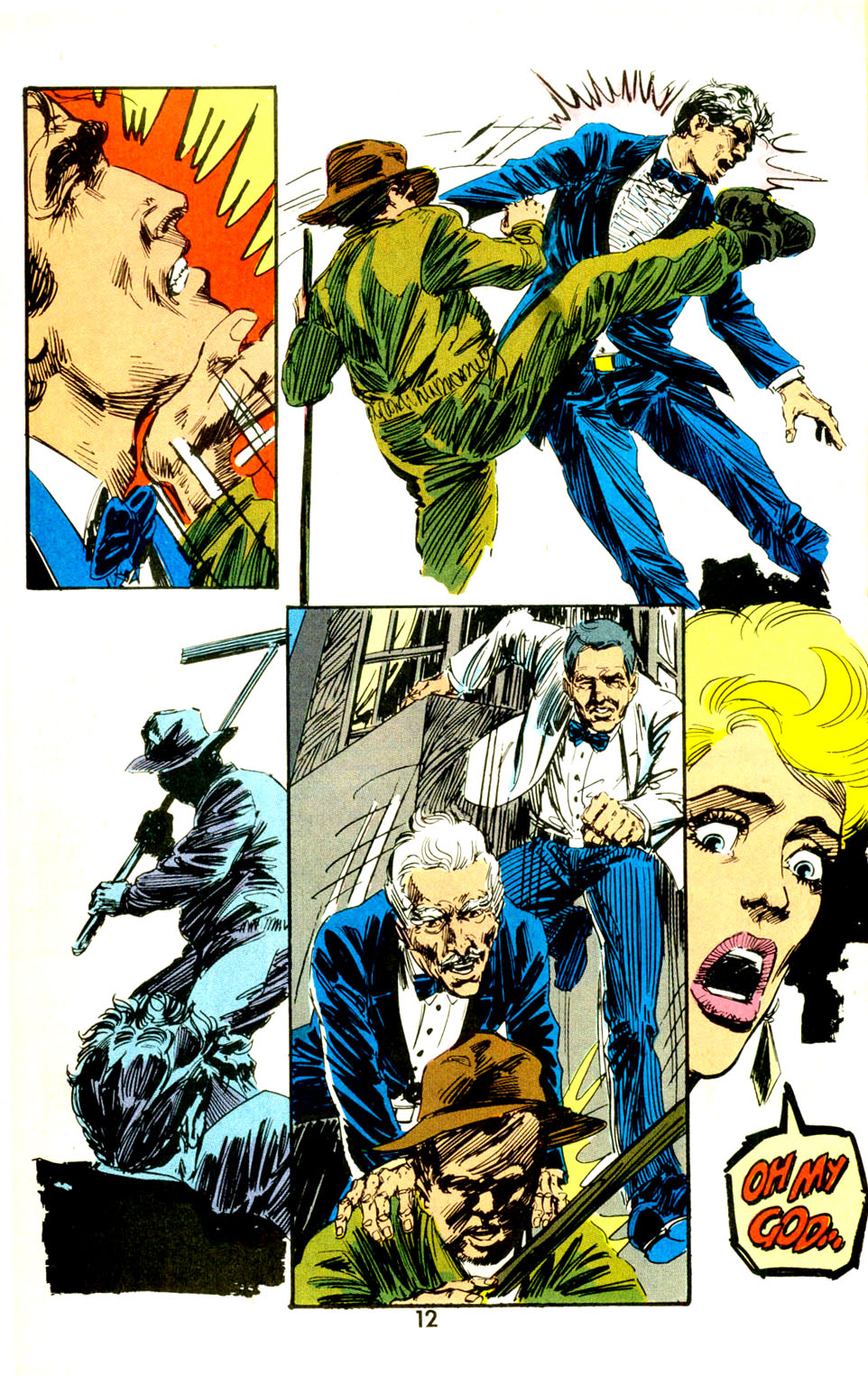 The "man" turns out to be the pool cleaner, Oyama. Jon drops Eden off and then he and Sonny take Witchita to a rather seedy-looking building, where he lives, which saddens Sonny and he asks Jon to take them home. Back at Sables, he is about to go inside, when he sees scratches on his door lock. he circles around the building and climbs in through e terrace and finds visitors.... 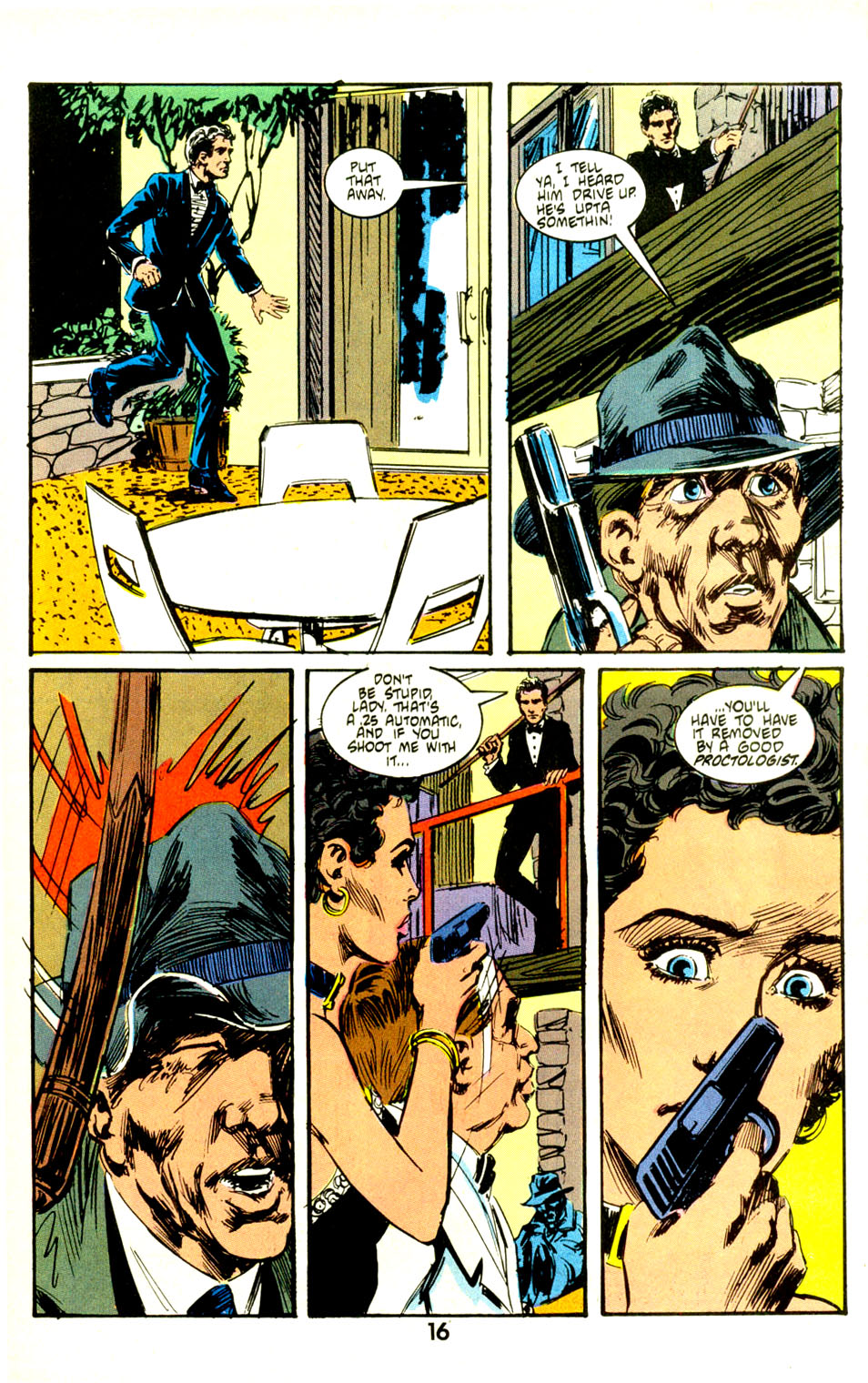 Greenberg offers Sable $50,000 to bring him the Falcoln, no questions asked. Jon tosses out Greeberg's hood and then tells him $100K. This upsets Jo Carr, who Greenberg chastises for failing to charm Mae Astin. Later, someone rings Sable's doorbell, while he is in the shower and he answers it, to find Wit, gutshot and holding the Maltese Falcon, wrapped in newspaper. Thoughts: This issue starts the investigation, as various sides either try to court Sable or warn him off. Typical! We learn that Mae Astin couldn't be pulling an insurance scam and the statue was too heavy for her to move alone. Greenberg offered her $100K for it, as well as Jo Carr, as a playmate. Grell is really playing up the original homosexual angle of the novel and first film adaptation, as there is only oblique reference in the 1941 version. As in the film, Greenberg's overtures to the detective (Sable here, Sam Spade in the film) anger Jo Carr (and Joel Cairo, played by Peter Lorre). Greenberg is not to be trusted by anyone, including his associates. The hood at Sable's place must be the stand-in for Elijah Cook Jr's Wilmer Cook, as he spends a good bit of his time getting roughed up and mocked by Sam Spade, just as this guy does, by sable. Oyama, the pool cleaner who is a martial arts expert may be a nod to Mas Oyama, the founder of Kyokushin Karate.....  Oyama was actually Korean, which was controlled by Japan and started studying martial arts at the age of 9, from a Chinese farmer. He eventually founded his own school and travelled around, givign demonstrations, including knocking bulls unconscious, with his bare hands. one of his students was the future actor Sonny Chiba, who portrayed him in a trio of films. The films were adapted from a manga series, Karate Baka Ichidai, by Ikki Kajiwara. Kajiwara was noted for his sports and martial arts-themed manga series, including the seminal boxing title, Ashita No Joe, and the pro wrestling themed Tiger Mask, which spawned live versions of the character, portrayed by wrestlers Satoru Sayama, Mitsuharu Misawa, Koji Kanemoto, and Yoshihiro Yamazaki. Grell's drawing of Oyama somewhat resembles Mas Oyama, in his later years. Lt Chambers is basically there to draw out exposition, in a role filled int he film by Barton MacLane, as Lt Dundy and Ward Bond, as Det. Polhaus. Witchita ending up dead, with the Falcon, mirrors the murder of Sam Spade's partner, Miles Archer (I mistakenly listed him as "Lew Archer," in the previous review. Not sure where I got that, though it is the name of a villain, played by Nigel Havers, on the British soap opera Coronation Street. I've never seen anything but clips of Coronation Street, so your guess is as good as mine on that brainfart. Actually, the death scene for Wit is based on one where the captain of the ship La Paloma, stumbles into Spade's office, dead, clutching the Maltese Falcon (wrapped in paper); but, Wit is fulfilling both roles, as a sort of "partner" to Jon (through Sonny) and the captain of La Paloma, copying his death scene. I always chuckle at Sable telling Jo Car that if she shoots him with her .25 cal automatic, she will just make him mad. This kind of follows a chapter of Ian Fleming's Dr No, where the Armorer, Maj Boothroyd, issues Bond his new Walther PPK. previously, Bond carried a .25 Beretta (the Walther is a .32 cal), which Boothroyd calls a "lady's gun," as it has no stopping power. While that is true, it all depends on where you shoot the person. Plenty of people have been shot and killed by .25 cal pistols, which were designed to be compact and concealable, for use at short range. The chapter came about after a fan letter from Geoffrey boothroyd (for whom the character was named), a firearms expert who chastised Fleming for giving Bond the Beretta (Fleming liked the name) and suggested the Walther, though he actually lobbied for the Smith & Wesson Centennial Airweight, a revolver, with no hammer spur, designed for bodyguards and plainclothed police. It was a .38 caliber, which is the rough equivalent of the 9mm parabellum (not exactly, but similar in size and power). Fleming, as usual, got it wrong, in Dr No, and said the centennial was for long range work, but it is too light of a caliber, for that. Boothroyd had suggested a Colt .45 revolver of S&W heavy caliber revolver. Fleming liked the sound of Walther PPK and it became Bond's weapon (it, too, was a favorite of police). In the 1941 film, Sam Spade carries the Colt M1911 automatic, while Joel Cairo (Lorre) has the much smaller Colt Model 1908 Vest Pocket pistol (in .25 ACP). Miles Archer is shot with a Webley revolver. Wilmer carries twin Colt M1911s. Greenburg's hood has a .45, while Jo has the .25 ACP (though a more modern one than Lorre's pistol). The Maltese Falcon continues to be great fun and it concludes next issue, as Jon figures out who did it and who shot Wit (not not JR). The answer will have some parallels to recent events on movie sets. Just for fun, Sam Spade dealing with cheap hoods...
|
|
|
|
Post by codystarbuck on Nov 18, 2021 0:06:17 GMT -5
Jon Sable #30 There is no showgirl in this story or the novel (or film); so, I guess Grell wanted to draw a pretty, leggy woman. I got no issue with that! Creative Team: Mike Grell-story & stolen art, Ken Bruzenak-purloined letters, Janice Cohen-colors of money, Mike Gold-crime editor Letters page is more praise, and someone tried the phone number on Jon's business card, which was some kind of gag. Synopsis: Capt Josh Winters is at Sable's home, after Sable called him about the murder of Wit, though he has trouble believing this is all about the Maltese Falcon. he makes Jon go over the story again, for the benefit of new readers... 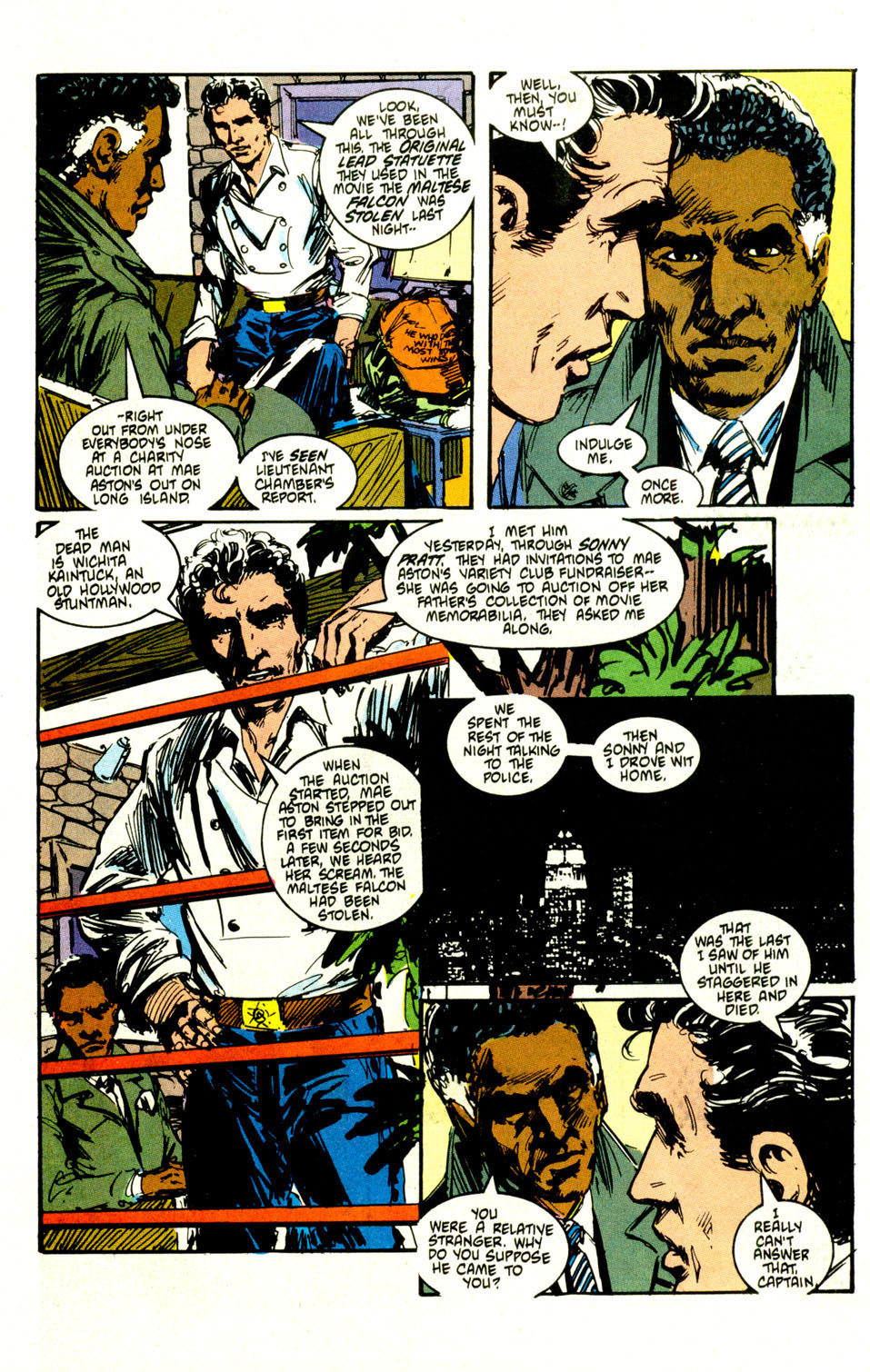 Jon says he doesn't know why Wit came to his place, other than Sonny's place is down the street and maybe he couldn't make it that far. He doesn't mention that With had the Maltese Falcon prop and Mike Grell seems determined to draw our attention to a humorous ballcap that seems out of character for Jon... 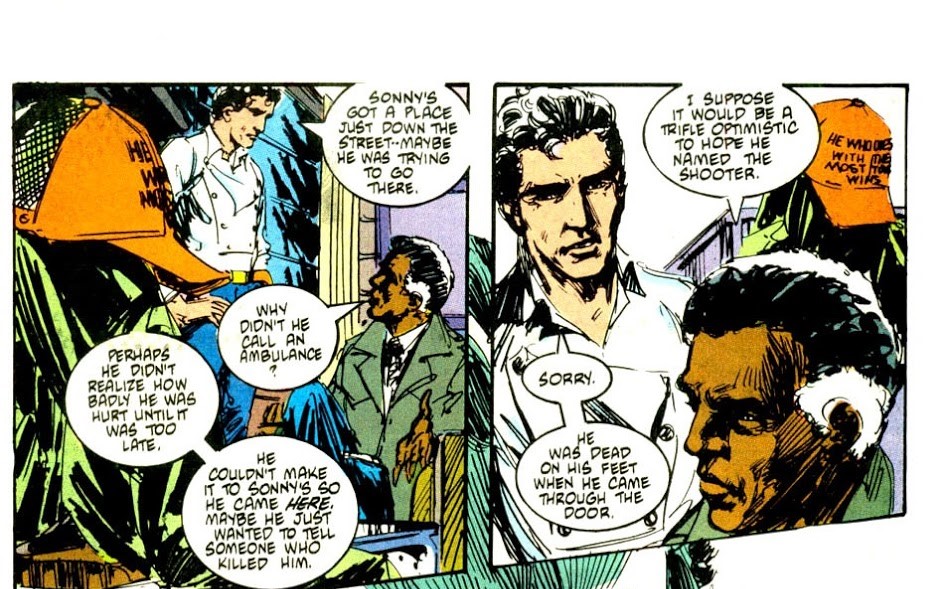 Winters leaves but tells Sable to stay out of the case, but knows he won't and he owes him for backing up Officer Rhodes (the one that shot Jon); but, he will have his keister in a sling if Winters finds out he has been withholding evidence. Like a stolen statue, hidden under a shirt and tacky ballcap. Jon calls Harold, his contact at the police department clerical section and asks for autopsy results for Wit and anything he can find on Stanley Greenberg. Jon is interrupted, as he was about to uncover the Falcon statue, by the front doorbell. It's Mae Aston, wanting to hire him to find the statue, offering half of the auction price, upon recovery and sale. he mentions Greenberg's offer and she agrees to meet it; but Sable says it won't cost her. he started investigating for fun; but, now it is personal (Isn't it always?) Mae mentions that Wit was acting strange and starts to suggest him as a suspect and Jon tells her he is dead. She finds that convincing evidence and suggests he had a falling out, with an accomplice..... 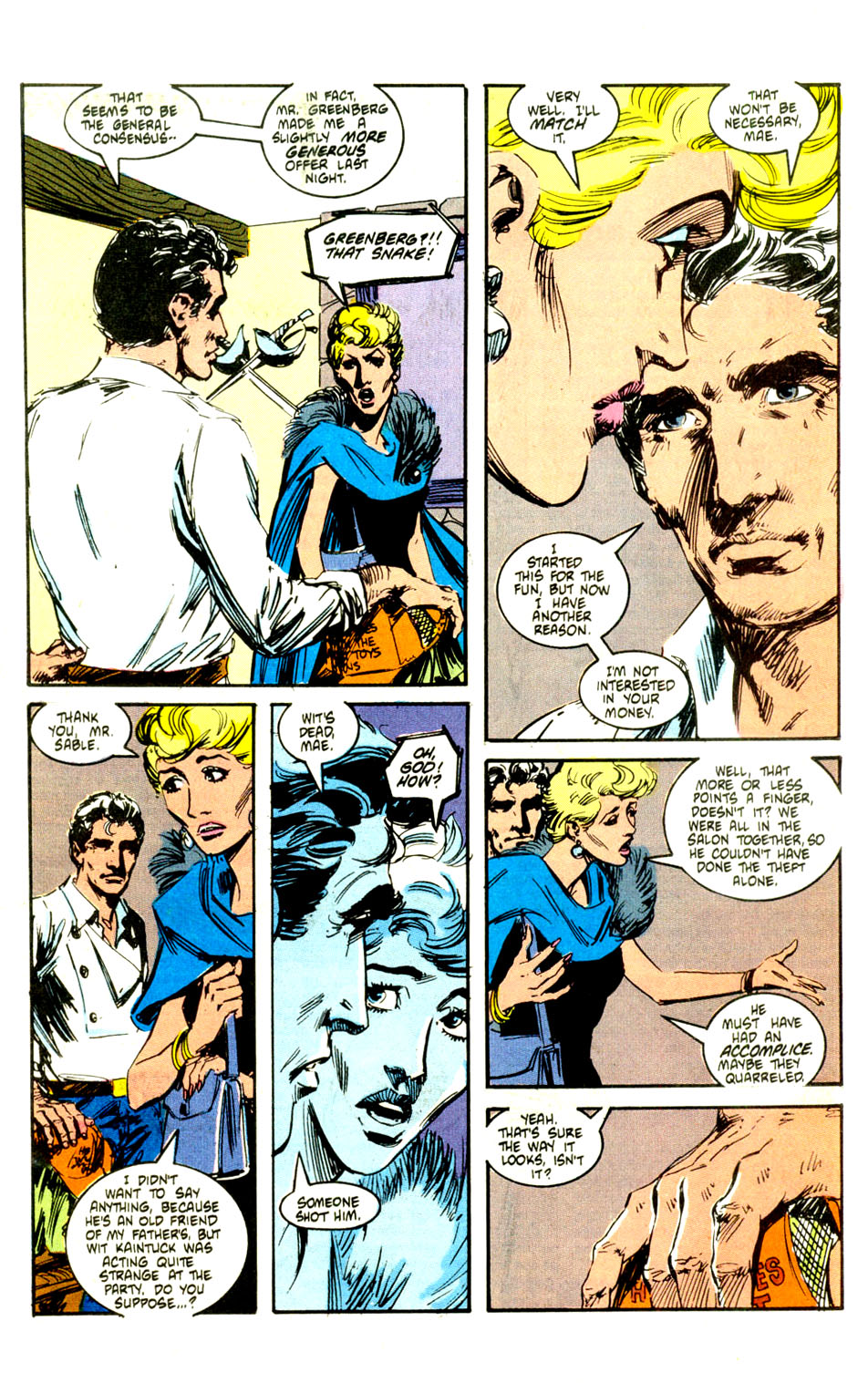 Sable goes to Wit's apartment and the landlady lets him in. She mentions that he was never any trouble, but seemed to have a taste for expensive hookers, mentioning a high class-looking one that visited around 7. They find Wit's apartment rumbled. Jon checks in with Harold to see what he has.... 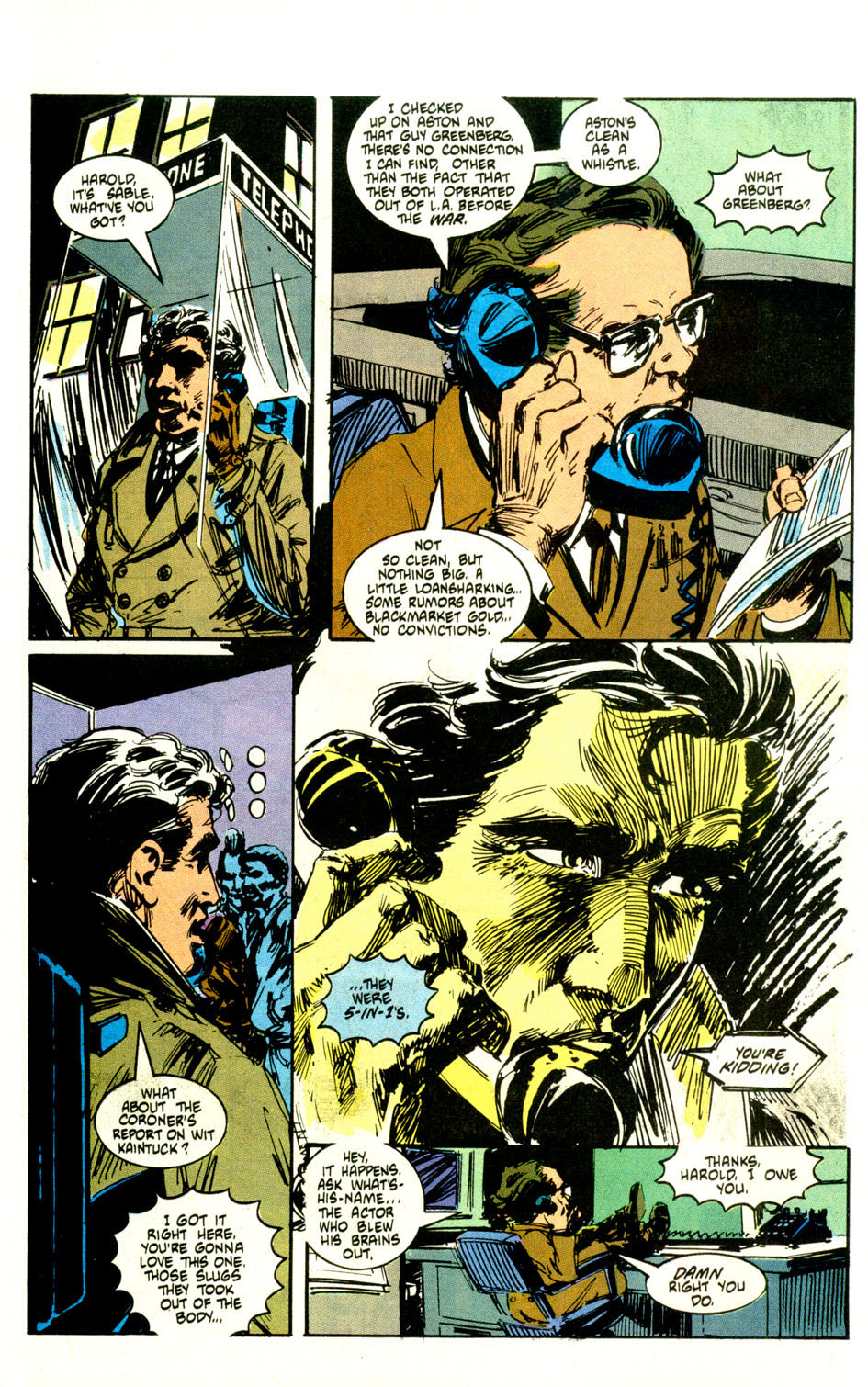 Greenberg has no major crimes and Wit was killed with blank rounds, like Jon-Erik Hexum.....  Jon next calls Greenberg, who asks if he has the Falcon. He is desperate to get his hands on it. Jon says not yet, but to meet him at Mae Aston's. He is checking over his Mauser, while he is on the phone. Out at Mae Aston's, she enters the house to hear the sound of "As Time Goes By," played on Dooley Wilson's piano, by Jon..... 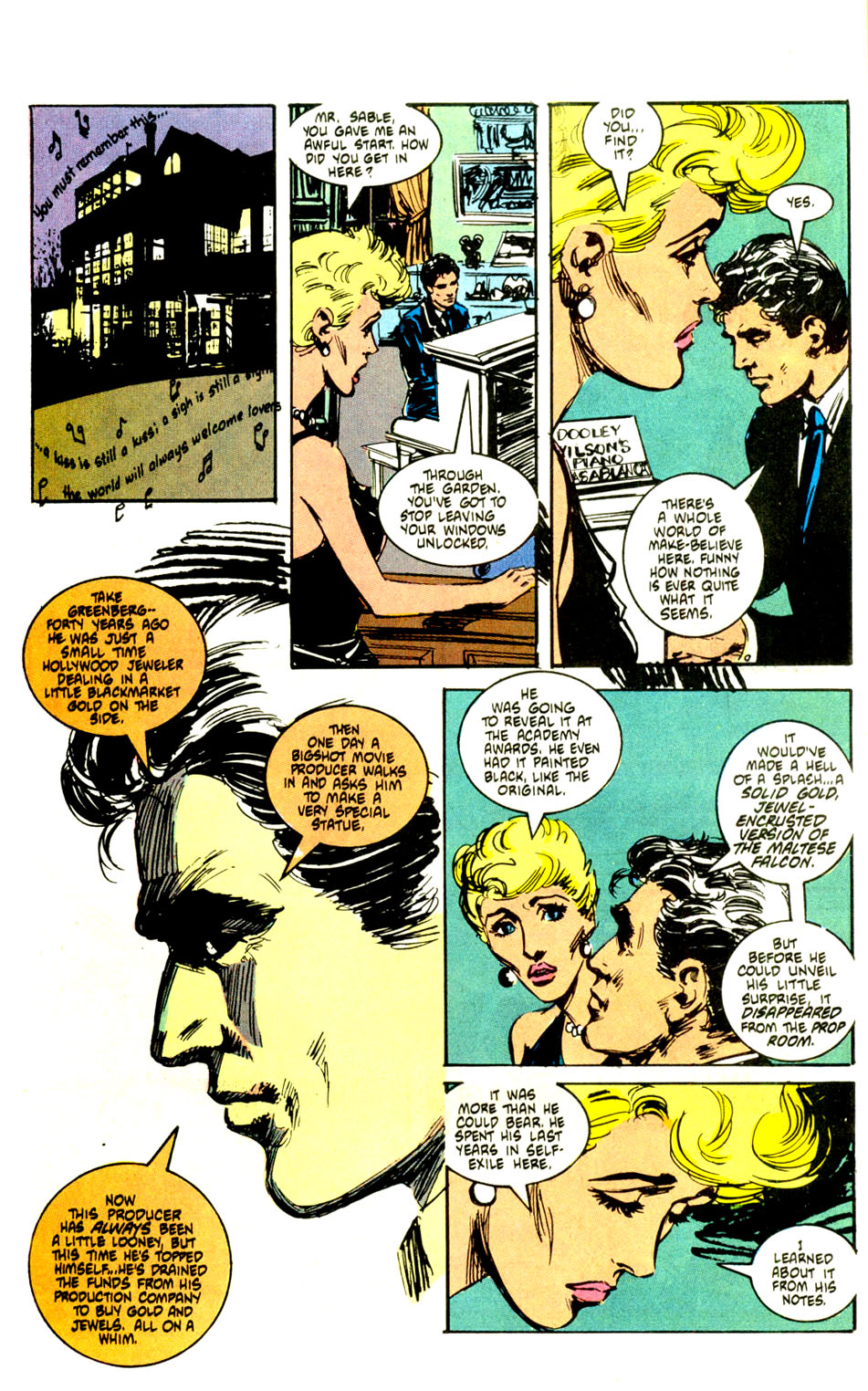 Greenberg was a small-time Hollywood jeweler, with a side racket in smuggled gold, who hooked up with hotshot Hollywood producer Miles Aston, who commissioned him to make a gold and jewel-encrusted replica of the Maltese Falcon, to be revealed at the Oscars. It was painted to look like the prop statues, but was stolen from the prop room. Mae admits to learning about it from her father's notes. 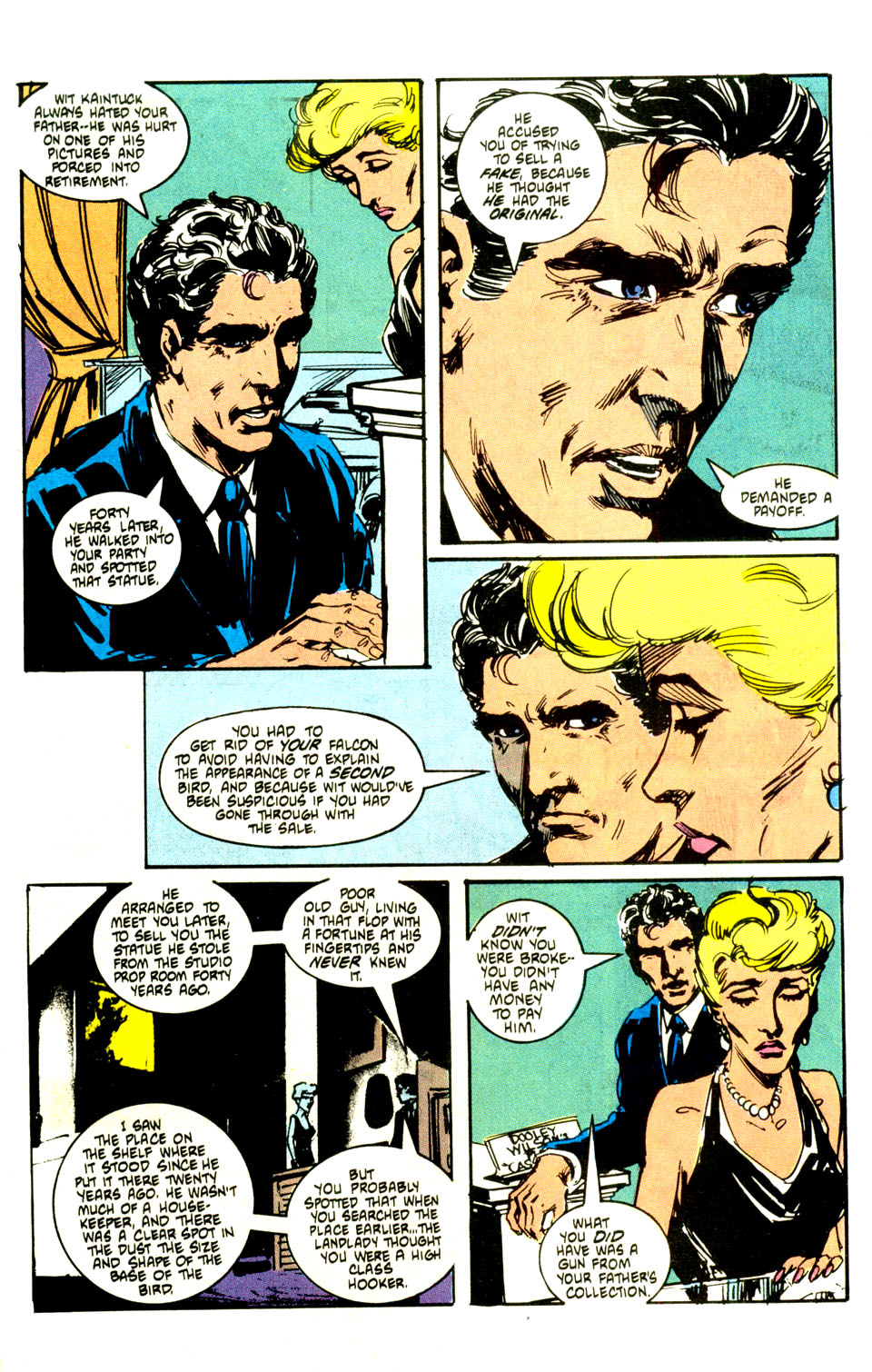 Wit confronted Mae about the fake statue and threatened to expose it. So, she faked the theft and then Wit was going to sell her the real one; but, he turned up dead. Mae was the "high-class hooker" that the landlady saw at Wit's place and is the one who rumbled the apartment, looking for the statue. She also had the prop S&W Model 29 pistol, from Dirty Harry and she shot Wit with it, not knowing that it was loaded with 5-in-1 blanks. However, at close range, the blanks are still dangerous as they can propel the wadding at sufficient velocity to penetrate the skin or hit with enough energy to cause damage. Three were enough to kill Wit. He explains this after Mae tries shooting him and he retrieves the wadding, unhurt. Greenberg turn up with his gunsel and Jo Carr, threatening to shoot them unless he gets the statue. Jon says the police will want it as evidence, unless they can pin the theft on a cheap hood and asks Greenberg is he knows one. Jo chops the gunsel in the back of the neck and he hits the floor, unconscious. Jon then says he doesn't believe that Josh Winters will fall for that. Greenberg loses his patience and demands to know where the statue is. Jon tells him it is at the bottom of the pool, where Mae Aston dropped it, out the window, before screaming. That was why she tried to make Jon think Oyama was a prowler, to prevent him from finding it. Greenberg rushes forward to see and Sable trips him and he tumbles out the window, into the pool. Jo then points her pistol at Jon and he reminds her what he said he would do with it, if she shot him. She shrugs and tosses it away, then hits him with a roundhouse kick to the head. She follows up with a flying side kick and Jon ducks and she also ends up out the window, into the pool. Jon tells them he had a friend call the police. He tells Greenberg he is welcome to try to get the 60 lb statue off of the bottom of the pool. Lt Chambers arrives and Greenberg, Carr, the gunsel and Mae Aston are hauled away. A cop brings him the stolen prop statue, from the bottom of the pool and Jon then gives him a present for Capt Winters, wrapped in newspaper. he asks what it is and Jon starts to answer, but says "Naaaaahhhhhh...." Thoughts: So, Mike takes the homage all the way to the end, as Mae Aston goes down, just like Mary Astor, in the Maltese Falcon. She murdered Jon partner, of sorts, in Wichita Kaintuck, just as Brigid O'Shaugnessy murdered Miles Archer, Sam Spade's partner. Jon suggests setting up a patsy, to Greenberg, just as Sam does to Guttman, leading to Wilmer taking the fall for killing Floyd Thursby. Jo Carr and Sydney Greenberg turn on the hood, just as Guttman and Joel Cairo do to Wilmer. Mae Aston was the killer, though Greenberg was willing to kill. Josh Winters and Lt Chambers stand in for Barton McLane and Ward Bond. I kind of like what Grell did with Jo Carr. Both Jo and the original Joel Cairo are homosexuals, who kill for their fat bosses. Joel was played by Peter Lorre, who was short and hardly handsome, as well as male. Jo is tall and gorgeous, as well as female. It makes for a nice twist on things, while Greenberg is pretty much Sydney Greenstreet, minus the charm. The mystery is easy to solve if you had seen the film (or read the novel); so, that isn't the real attraction, apart from seeing Grell adapt it. No, the attraction here is to see Grell's love letter to a classic film, the one that popularized the hardboiled detective, in Hollywood, just as Dashiell Hammett (and Raymond Chandler) popularized it, in fiction. Without Hammett and Sam Spade, there is no Mickey Spillane and Mike Hammer, or Robert Parker and Spenser or even Sara Paretsky and VI Warshawski. Grell's twist is timely, as it is built around an on-set accident with a prop gun, such as the recent one that resulted in the death of Halyna Hutchins, on the set of Rust. Grell references the then-recent death of actor Jon-Erik Hexum, on the set of the tv series Cover Up. Cover Up was a spy/adventure series, starring Jennifer O'Neill and Hexum, as secret agents who masquerade as a fashion photographer and her male model. The series was a rating winner and quite good and Hexum proved to be a fine actor. On October 12, 1984, Hexum was shooting a scene where his character loaded a S&W Model 29 .44 Magnum revolver and had a working pistol, loaded with blanks. The director wasn't satisfied with the master shot and they were resetting the scene, but there were delays and Hexum started fooling around with the pistol and started playing Russian Roulette, as a joke. However, he discharged a blank at close range to his temple and the blunt force trauma of the blank round was enough to fracture his skull, dislodging a piece of bone into his brain, causing internal hemorrhaging. Hexum was rushed to the hospital and emergency surgery was performed, but he was declared brain dead 6 days later. His body was kept alive on life support, so that his heart and other organs could be transplanted. Hexum's heart was transplanted into 36 year-old Las Vegas man, both corneas were used in transplants for a 66 year-old man and a young girl, one kidney was donated to a 5 year-old boy, the other to a 43 year-old woman, who had been waiting 8 years for a kidney donor. Skin was used to treat a 3 1/2 year-old boy, with 3rd degree burns. Grell's version has Mae fire the blanks at close range and 3 expelled waddings, into the abdomen, are enough to kill Wit, though this is questionable if it would have that effect. At the time, it was reported that the blank wadding in Hexum's gun penetrated his skull. It was only later revealed that the wadding did not penetrate the skull, but, that the force of the discharge fractured the skull and a piece of bone create the hemorrhage. Similar misunderstandings occurred in the death of Brandon Lee, in 1993. At the time, some reports stated that a "dummy round" had been dislodged and penetrated his abdomen, ultimately killing him. What actually happened was that a scene was shot with a dummy round, to show the round in the cylinder of the .44 Magnum revolver (also a S&W Model 29, I believe). The film did not use an experienced Hollywood armorer and the people in charge of the weapons had made their own dummy rounds by removing the propellant charge from a cartridge. However, they failed to remove the primer and it was ignited during the scene. Lacking the propellant in a normal cartridge, the bullet was dislodged from the casing, but not with enough force to exit the barrel of the revolver. It remained lodged in there, when the weapon was reloaded with blanks, to shoot a scene. When the trigger was pulled, the blank round released enough pressurized gases to propel the lodged dummy round from the barrel and into Brandon lee's abdomen, fatally injuring him. Some reports led people to believe that the dummy round contained propellant and had launched the bullet into Lee, rather than a combination of the dummy round's primer, and the blank rounds powder charge. Both accidents led to increased safety protocols for firearms on sets; but, protocols are only as good as their enforcement. The Crow, where Lee was killed, had multiple on-set accidents, due to a rush to film and unsafe working conditions, partially fueled by budget concerns. Parallels have been drawn with the set of Rust, in media accounts. Firearms are not something to ever treat lightly, which is something Grell emphasizes in Jon Sable, with the possible exception of his jokes about Jo Carr's .25 ACP pistol. Quite frankly, I wish he had been a bit more sensible and included someone who was shot with it, to emphasize the fact that a low caliber weapon can still be lethal, if the bullet hits the right target. That joke might have been find in an issue of Guns & Ammo; but, the reality of the situation warranted a bit more of a dose of reality. I may not have made it clear, in the synopsis; but, there were two Maltese Falcon prop statues (there were several, for the real film). Wit stole the gold replica that Miles Aston had made, by Greenberg, from the prop room, as revenge for being injured on the set of one of Aston's pictures. He knew how much it meant to Aston, so he stole it. He had it in his apartment for years and when Jon looks over the place, he sees the ring of dust around the clean spot, where the statue had resided, for all these years. Wit had no idea that he had stolen the gold one that Greenberg created. Aston had one of the movie props, not the replica he commissioned and Mae learned of this. Wit confronted her with the news that her statue was a fake, so she learned who had the gold one. She faked the robbery by carrying her statue to the window and dropping it into the pool. Wit was then going to sell her the real one, but she killed him. However, he had the statue with him, when he died of his injuries, at Jon's doorstep, passing the gold one on to him. The police find the lead prop Falcon in the pool, as Jon describes, and then he hands the gold replica to Chambers, as he leaves, just as Sam Spade hands over the Falcon to Det Tom Polhaus. The Falcon, in the film, is supposed to be gold, encrusted with jewels, and hidden under black lacquer paint. Miles Aston had Sydney Greenberg fashion a real gold Falcon, and paint it, as in the film, for himself, to be revealed at the Oscar ceremony; but, Wit stole it from where Aston hid it, in the prop room, as if it was the actual prop version. Aston has to cover it up with an actual prop version, while he spends years trying to find his gold replica. Next time, Mike takes a page from the men's adventure pulps (like Mack Bolan and his ilk), as Jon finds himself recruited to lead a team of mercenaries on a mission to Nicaragua, in "The Gauntlet."
|
|
|
|
Post by codystarbuck on Nov 23, 2021 0:41:26 GMT -5
Jon Sable #31 Jon has gone full-blown McCarthy! He's hunting Commies! Creative Team: "Mad" Mike Grell-story & art, planning & CO, Ken "TNT" Bruzenak-letters, support weapons; Janice "Dye-Dye" Cohen-colors & explosives, Mike Gold-editor, paymaster, cannon fodder Letters page has more praise, a request for Grell to come to Australia and a recommendation of the comic as literature suitable for adolescent males, as it provides positive role models. Next you'll be telling me that comics don't turn you into a slobbering maniac, killing at random and pillaging the community! So, for this two-parter, I suggest a little side reading from the era:    Phoenix Force and SOBs were men's adventure pulp novels, published by Gold Eagle Books (which is an imprint of Harlequin; so, yes, the same people with the cheesy romance books were churning out blood & bullets adventure novels, and westerns!), spinning off from the Mack Bolan books (well, Phoenix Force did; SOBs was just similar fare). In the 70s, it was about fighting the mafia, Nazis and Commies. In the 80s, it was about fighting terrorists, Commies, Mafia and ninja. Phoenix Force was a group of 5 specialists recruited from several nations, to carry out special missions for a division of the National Security organizations, called Stony Man. There was also Able Team, a 3-man bunch, who actually debuted as characters in the second Executioner novel, back in the late 60s, but didn't get their own series until 1982. These guys would go off and fight terrorists, sugar-crazed boy scouts, Amway Salespeople, and Loansharking Girl Scouts, every month. Usually, they got new firearms in each book and several paragraphs would be given over to describing them. The books would climax in a big gun battle. SOBs were a bunch led by a guy named Barrabas (Soldiers of Barrabas) who are mercs. Their first adventure has them hired to rescue and African leader from a psychotic enemy, which was a rip-off of Daniel Carney's Wild Geese, which was a rip-off of Frederick Forsyth's The Dogs of War, which was inspired by actual mercenaries he met and worked with while reporting on and aiding the cause of the Bifran Sepratists, in the Nigerian Civil War. Carney wrote a manuscript that borrows some of the structure of Forsyth's bestseller, but without any of the expertise, and fantasizes a group of idealistic mercenaries who attempt to rescue a deposed African leader, who was modeled after Moise Tshombe, who was hardly an inspirational leader, who was deposed in the Congo, by Joseph Mbutu (who also deposed Patrice Lumumba, earlier, while Lumumba was fighting a civil war against Tshombe and his mercenaries, in the secessionist Katanga Province). So, a merchant banker hires the mercs to get the guy out, then double crosses them when he makes a deal with the current regime (the rescue mission was a bargaining tool in negotiations for mineral rights; either the government sells them concessions or they back the deposed leader in a counter-coup). Carney wrote a manuscript that got bought to develop a movie, which eventually starred Richard Burton, Richard Harris, and Roger Moore (as well as Stewart Granger, Hardy Krueger, Winston Ntshona, and T'Chaka, himself, John Kani). The novel got published to tie in with the film. Carney was actually from Rhodesia, before it gained majority rule, in 1980. Carney had served in the British South Africa Police, which fought in the bush wars that inform Jon Sable's Africa backstory. Funny old world, innit? Synopsis: Jon and Myke are still making sweet love down by the fire, despite the somewhat conflicted conclusion to their first go-round. Jon is plague by memories of Elise and stares out of a window, at the rain, buck nekkid (so no page example) and Myke wakes up and asks him what is wrong? He tells her it is Elise's birthday and he forgot....  Myke tells him maybe it is a sign that it is time to move on. She reminds him that Elise would have wanted him to live and to live you have to move forward to the future. Jon embraces Myke and she holds him for a while. Later, Jon leaves and Myke goes into Grey's room because she needs a hug and some comfort, herself....  Jon is walking down the street, when a woman in a bright red roadster pulls up and tells him to get in and there is no time to explain. Being an idiot, Jon does just that, without pulling his gun! She takes him to a pier and tells him Captain Hook is waiting for him, on a sailboat. Jon asks if she is Tinker Bell and she asks if she looks like a fairy? Jon mumbles that sometimes it's hard to tell. Jon climbs aboard and goes below and sees a hook and the owner says he won't have time to reach his gun and Jon hurls his knife, which embeds itself by Captain Hook's head and draws his Mauser and Jerry says hello. Jerry Fetter, Jon's old buddy from Vietnam, tells Jon that he bought the boat with his share of the money from their MIA mission and the business with the woman was to get Jon to come. He has a business proposition, to pay back Jon for the Vietnam mission, plus, he needs Jon's expertise. The mission is in Nicaragua. Jon wants no part of it, when he hears that. Jerry tells him time is short and shows him SR-71 surveillance photos of a Soviet freighter, with crates that look like the packing crates for MIG fighters. The CIA believes they might be used for a surprise attack on El Salvador. Their job is to go in, do a recon and get photographic proof of the weapons and then send a signal and the military will launch a strike. The team will be extracted to deliver the evidence that will be used to playcate the UN. Jon asks where the rest of the team is and Jerry says they will meet by 1800 hours and Jon says to have them meet him for a "capture the flag" exercise and then he will decide if he is in. Jon meets up with Myke, later and tells her about the mission and she again says it is his decision and she won't try to stop him or give him approval. Later, Jon meets up with Jerry and tells him he is the umpire and it's Jon vs the rest of the team. They catch up and Jerry says it didn't work out with Sheila. he also says the only time he didn't have nightmares was when they went into Vietnam. Jerry describes the team. Aileen Saxon is a clandestine ops specialist (an lookalike for Maggie the Cat, if you ask me), but the rest of her background is total BS, despite Demi Moore movies that came out a decade later.  Ed Gardner is a demolitions expert, who served with the Rangers, in Korea and is an expert mountaineer... 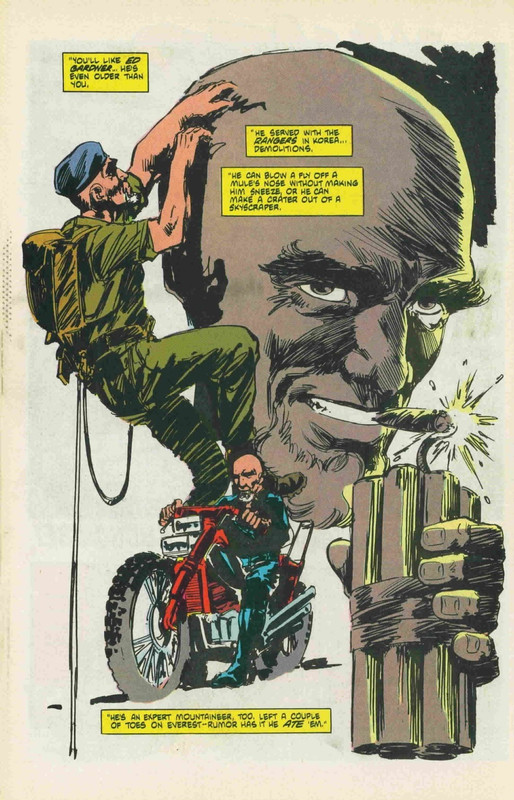 Mountaineer? (opens dictionary) Two men skilled in climbing mountains....Patrick O'Reilly was airborne, Vietnam, but got injured. Martial arts expert and pilot, and a wicked sense of humor....  Will Jordan, ex-Texas Ranger (as in Walker, not the baseball type), crack shot with a pistol.  Jordan leads the team, tracking Jon's trail, then Jon surprises them with a flash-bang grenade. Jon tells them he cheated. He gets an arrow through his flagstaff. jerry tells him he cheated and introduces him to Tahnee Hand, survival expert, primitive weapon specialist (and half Cherokee, half gypsy wildcat)  Jon asks Jordan about the story about shooting the nose off of a Mexican rapist who had crossed over the Rio Grande. he tells him the report had a typo, it should have read "hose." Jon briefs the team. They fly in as tourists, no weapons, just photos. If the defecation hits the oscillator, they will grab what they need from the locals. Ed Gardner asks if the group will have a name, and O'Reilly suggests World Airborne Response Team. Ed replies that would be WART and they can't call themselves the WARTs! O'Reilly then offers the alternate suggestion of Fast Action Response Team. Ed doesn't like that one, either, neither does Tahnee. Ed suggests something romantic, like The Gauntlet, as in challenging an enemy by slapping them with a gauntlet. Jon reminds him that the gauntlet usually gets stepped on, when the combat begins! Thoughts: The early part continues the development of Jon and Myke's relationship. Jon is starting to live in the now and forgets Elise's birthday, which tears him up and Myke reminds him that he is alive and must look forward. It's a nice moment in their relationship. Grell also has moved on from prohibitions against nudity, since First doesn't submit to the Comics Code and Myke is shown naked, though in shadow. Grell isn't ready to give equal time to Jon's tackle, though. The scene of Grey comforting Myke is nice, as it demonstrates the depth of their friendship, while Grey also makes jokes about Jon, which brightens Myke up. Later, though, we see the hurt in Myke as she knows Jon is going off on another dangerous adventure, because he needs the thrills, wondering if he will come back. She won't stop him, as he would use that against her, eventually, and their relationship would end. She won't give her blessing, either, as Jon has to decide if the thrills are worth losing the future. Grell doesn't make it easy on Jon. The mercenary team is typical of the books I mentioned above and most literature and film of this type. You usually have a team of specialists, with unique personalities, including a quiet one and a jokester. It doesn't matter the setting, as you see the mix in things like The Magnificent Seven, The Professionals, The Wild Bunch, The Wild Geese, The Dogs of War, The Dirty Dozen, the original Inglorious Bastards, Guns of Navarone, The Green Berets and the like. There is always a hand-to-hand expert, a demolitions guy who blew up his house with his first chemistry set, the crack shot, the planner, the flyboy or driver, the tracker and the quiet, deadly killer. In the stories of this era, you started to get a bit of women's lib into them and added a female member of the team (usually as an infiltrator or computer expert; never a sniper, demolitions expert, or heavy weapons specialist). Aileen's background is the most fantasy as women were prohibited, by law, from undergoing combat training. That included Jump School, Ranger, Special Forces and similar training schools. In the US Navy, that also meant Basuc Underwater Demolition/SEAL School (BUDS), the training program fr the SEALs. Women were barred from serving on combatant ships and all submarines and could not qualify for carrier landings, as pilots, until about the time I was leaving the Navy, in 1992. The movie GI Jane tried to rationalize it as a Congressionally mandated test case, but it was SERE (Survive Evade Resist Escape)School, which is survival training for pilots, not BUDS, as depicted in the film. Even in 1997, women were barred from the type of training predicted and a Congressman or woman could not reverse that, without changing the law. However, by the time of the first Gulf War, women were moving closer to the combat lines, in support roles, which led to a handful of female POWs, during the fighting. The "War on Terror" put women directly into harms way. History is filled with women in combat, from Molly Pitcher to the Night Witches and female Partisans of WW2, to the women serving in the Israeli Army, who were in support roles, but still were involved in combat, during the various wars that followed the UN Mandate. Tahnee is the stereotypical Native American tracker, though Grell gives her a mixed background to muddle her ethnicity. He also jokes around with Patrick O'Reilly, who refers to himself as "Black Irish," which is a reference to Irish descendants with black hair, which some believe is related to the Irish who migrated to Spain, then returned to Ireland, in the early 1800s. More likely, it is related to mixing with other groups as the Celts came to Ireland, or from others who came to their shores (from Vikings to the Romans). Will Jordan is the cowboy, before Walker polished his badge, though not before Chuck Norris portrayed a different Texas Ranger, in Lone Wolf McQuade. Of course, we all know the Texas Ranger who really counts... 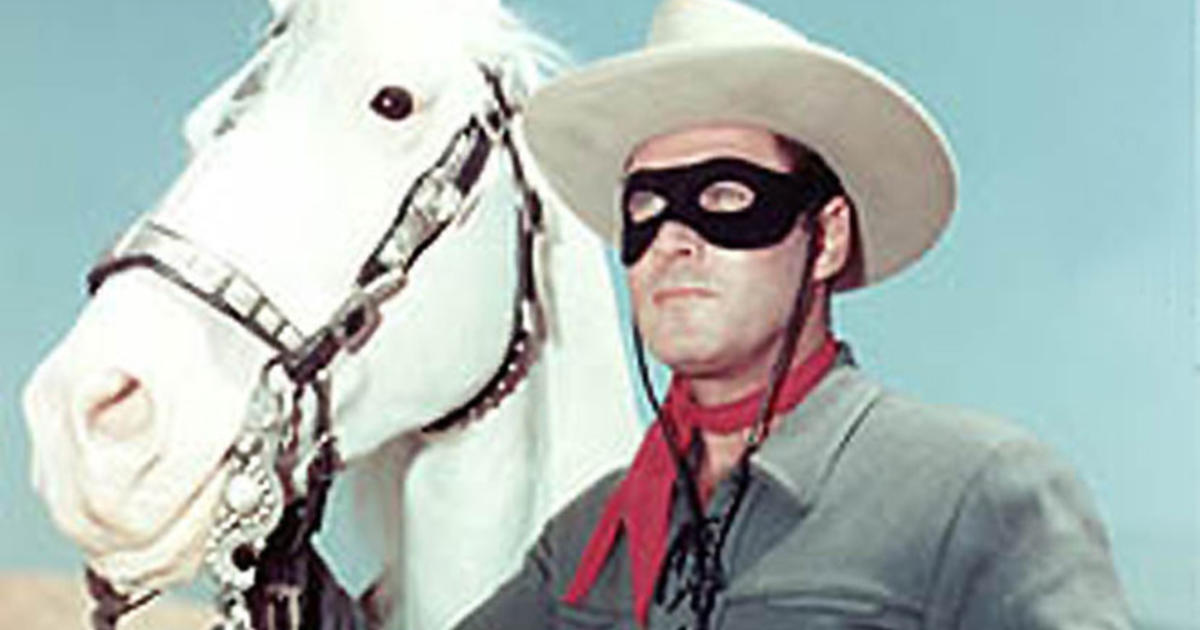 Who was that masked man? Ed Gardner is the oddball of the group and he sounds like he has been sniffing nitro for too long. That, or he likes his herbs. Grell will have more fun with him in Part 2. In reality, for a mission like this, the government would more likely send in a SEAL or Delta Force team to conduct a recon to confirm a target or trained agents. The ide of a mercenary team is more for Hollywood, as mercenaries aren't generally regarded as trustworthy and are mainly used for transport and the like, as with Eugene Hasunfus, the CIA contract employee (merc) who was caught by Nicaragua, when his plane went down, ferrying weapons to the Contras, touching off the exposure of the Iran-Contra Scandal, in 1986. The CIA had used similar merc pilots in the Vietnam War, under the name Air America, during the secret war phase, in Laos. The military has a rather dim view of mercenaries, which has usually been justified, from the Congo to Baghdad. During the Cuban Missile Crisis, the proof of Soviet ICBMs on Cuban soil was confirmed by SEAL operators (as well as U-2 flights). Still, this is fiction. Mike really should have tried his Jon Sable novel during this period, as the market for that kind of thing was there, rather than in 2000. The 80s were pretty much the zenith for the men's adventure pulps. By the 90s, they had been replaced by the technothriller. By the 2000s, even those were in decline, as the audience moved on to guys who hunt the nasties of society, like James Patterson's Alex Cross and Lee Child's Jack Reacher. However, the early to mid-80s were lousy with executioners, Penetrators, Destroyers, Death Merchants, mercenaries, Able teams, Phoenix Force, SOBs, Black Eagles, Nick Carter, Killmasters and more. Next time, the Gauntlet arrives in Nicaragua.
|
|













































